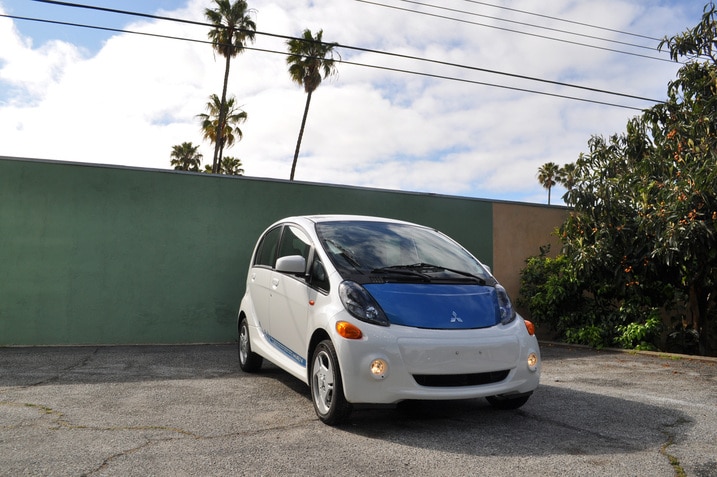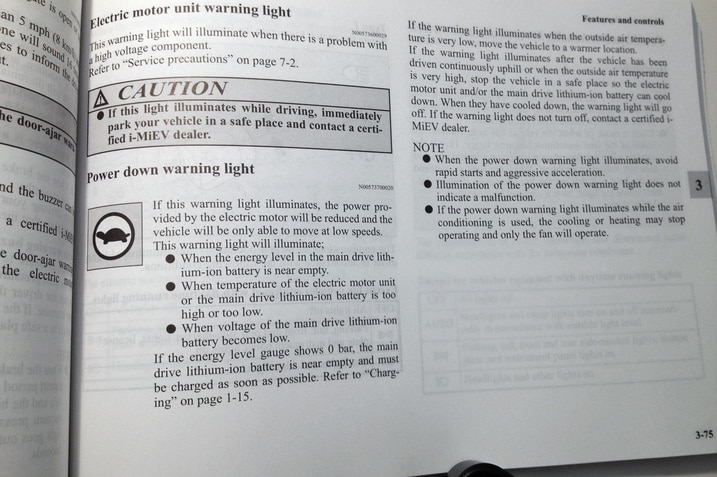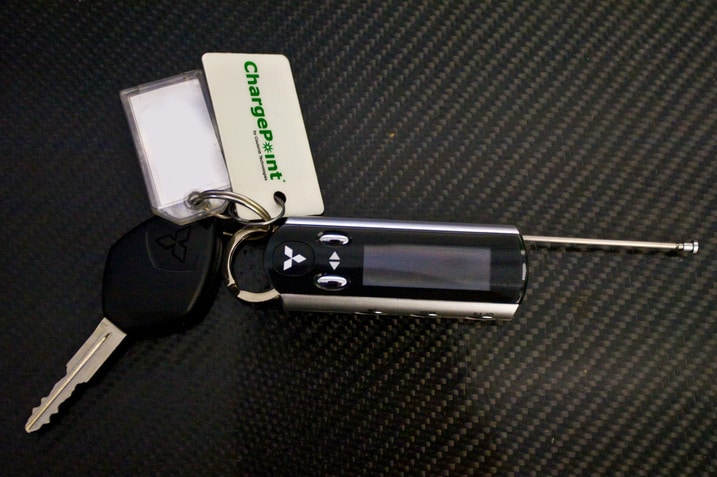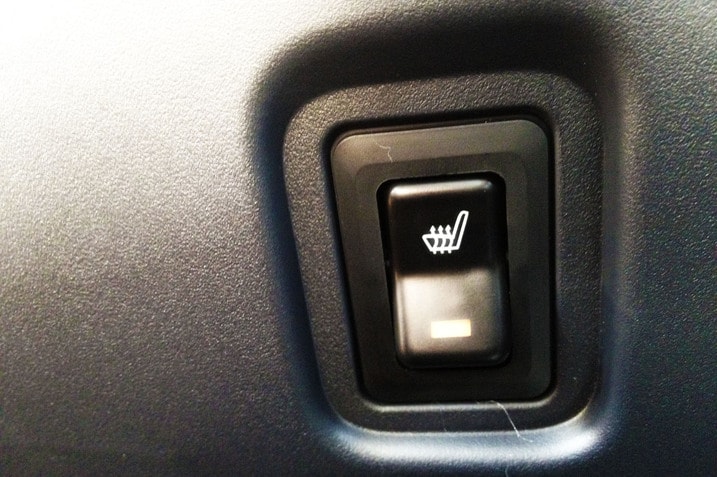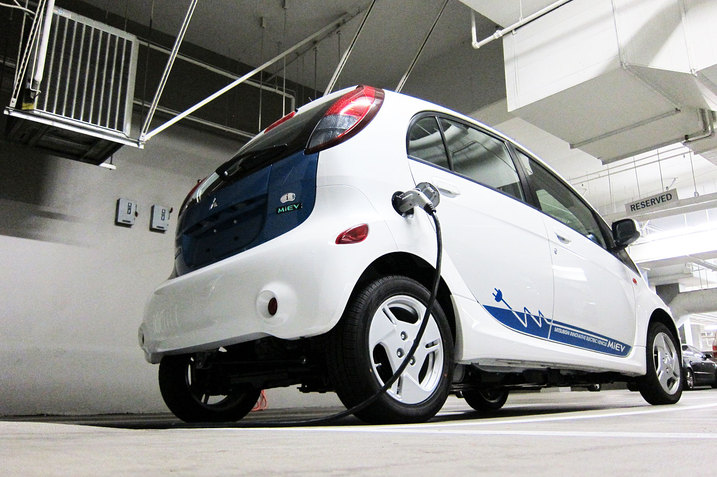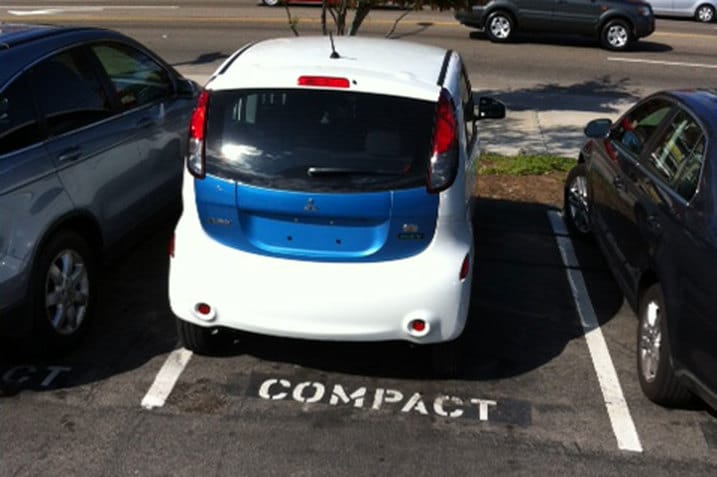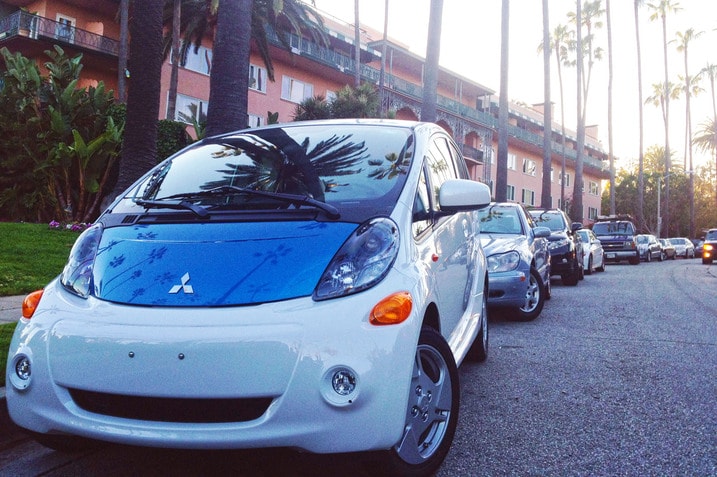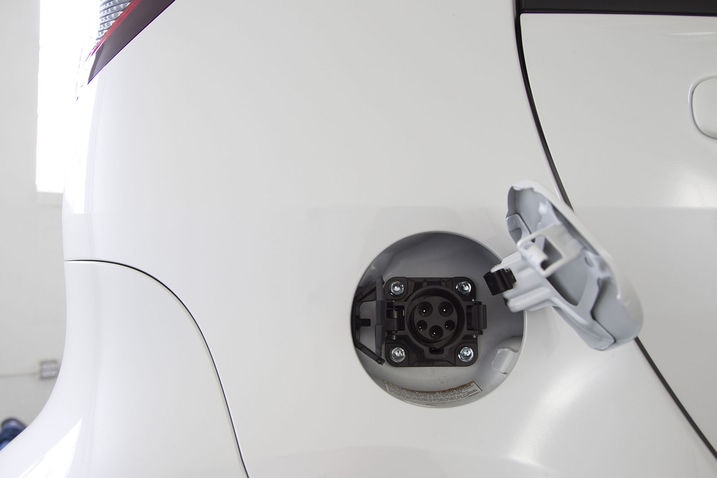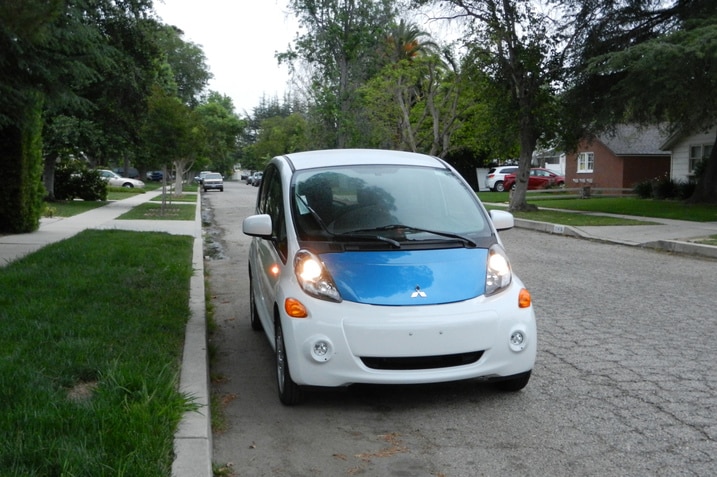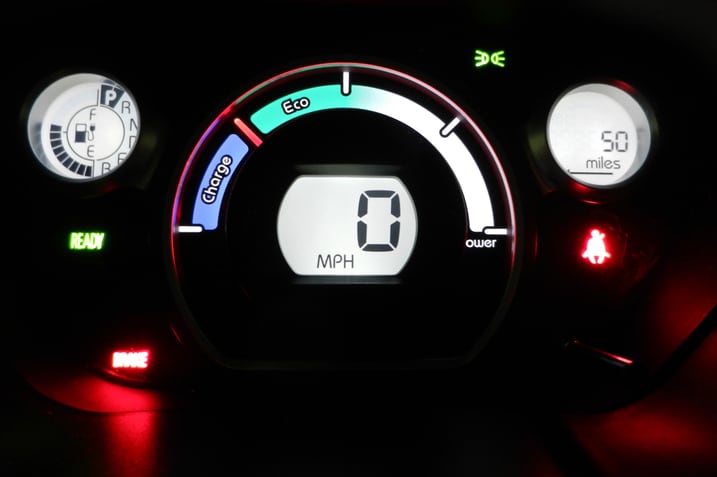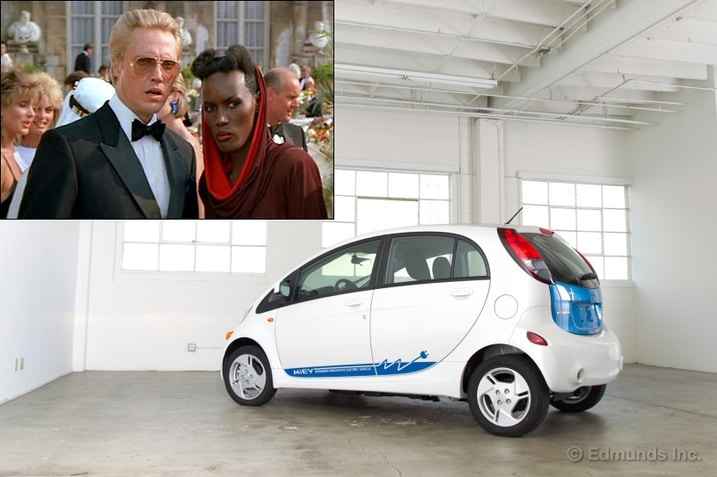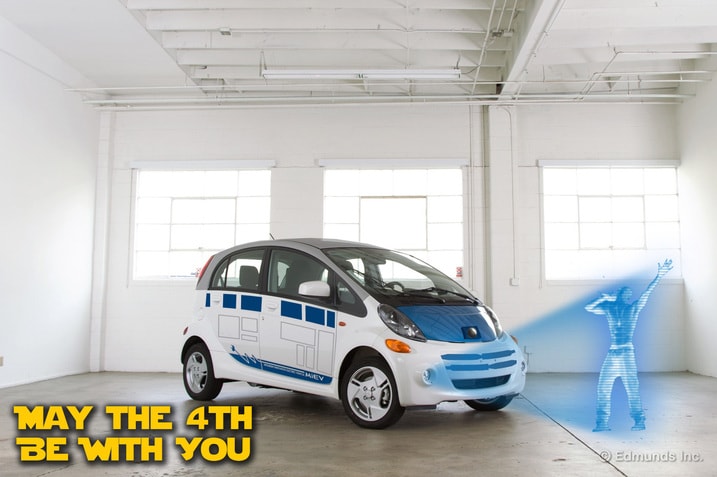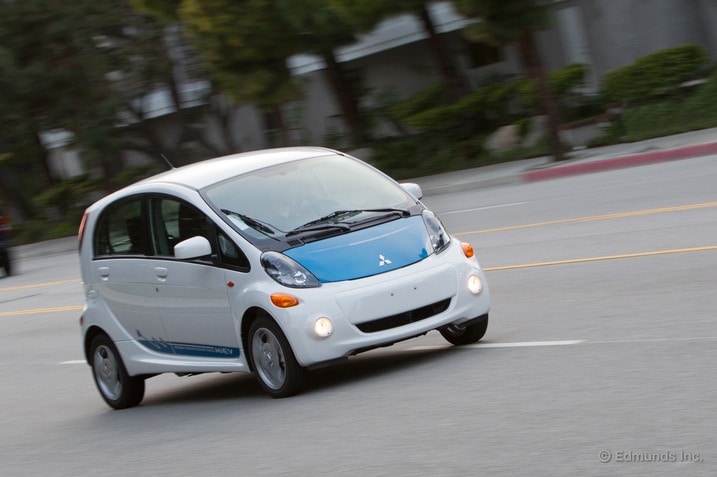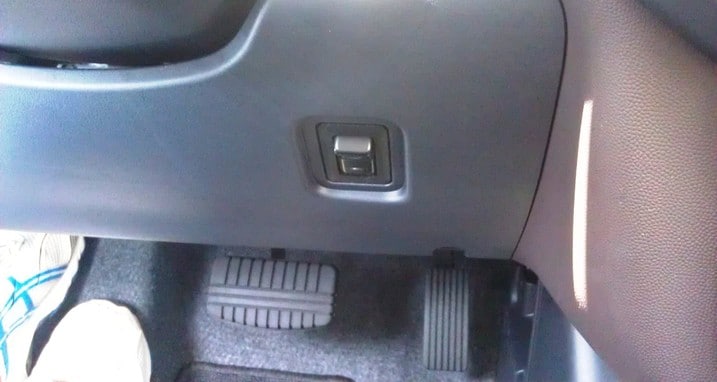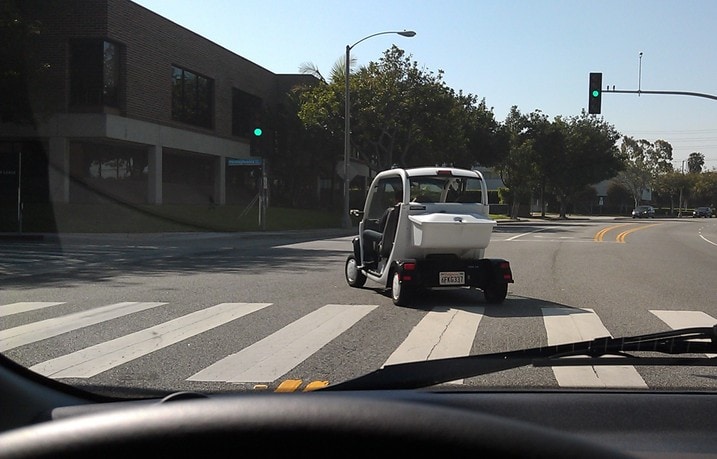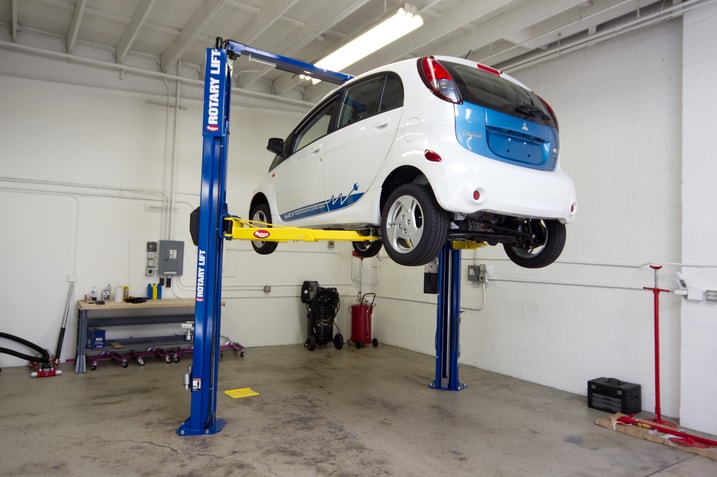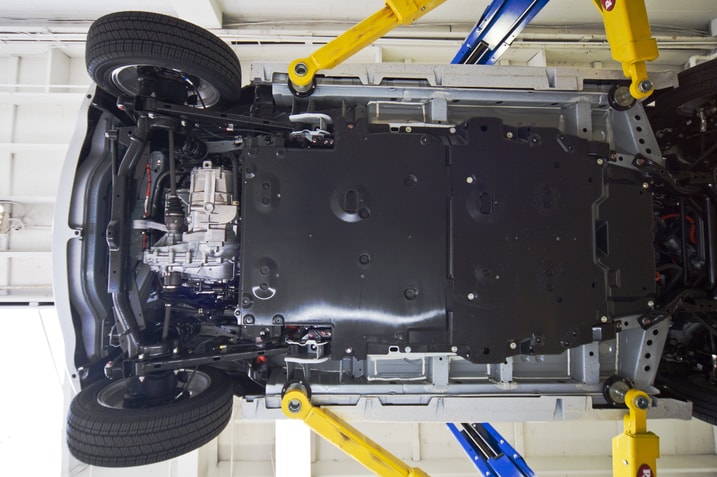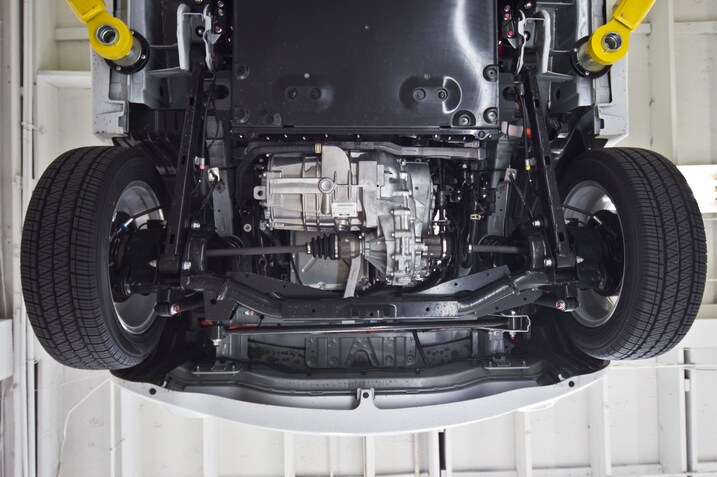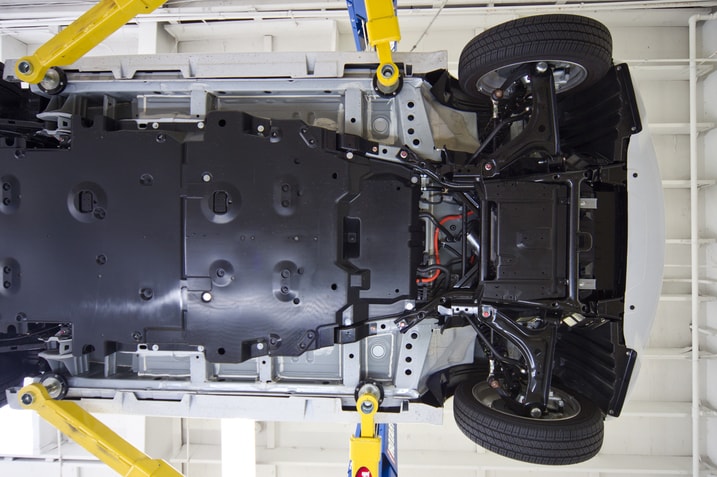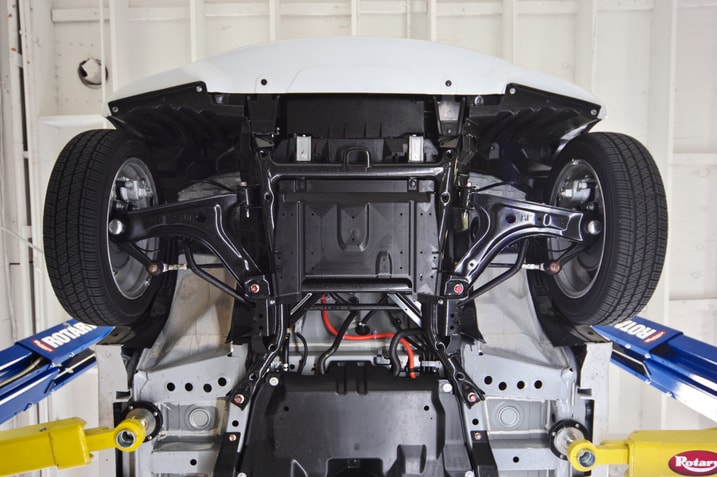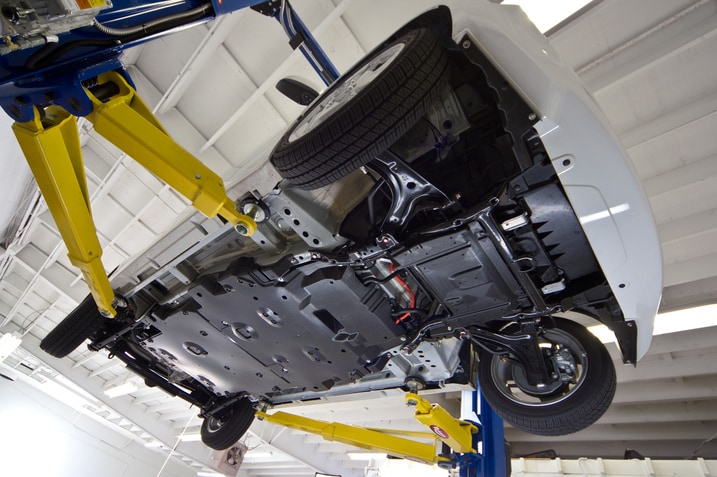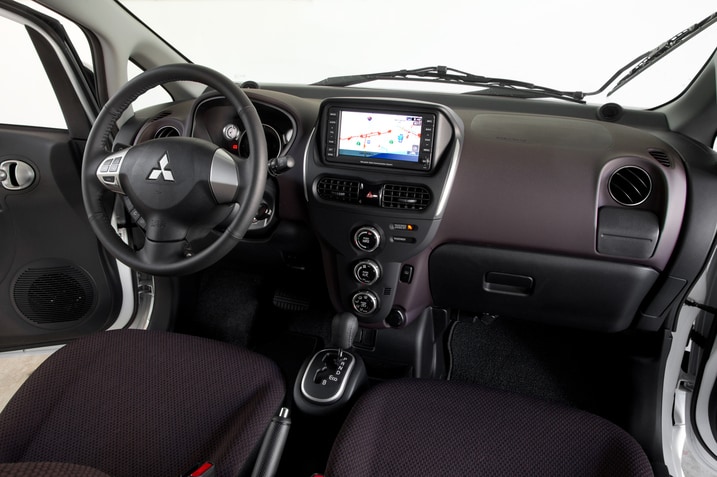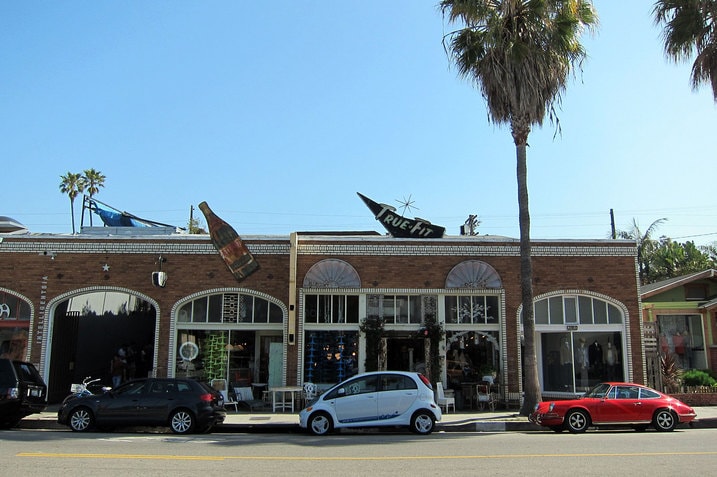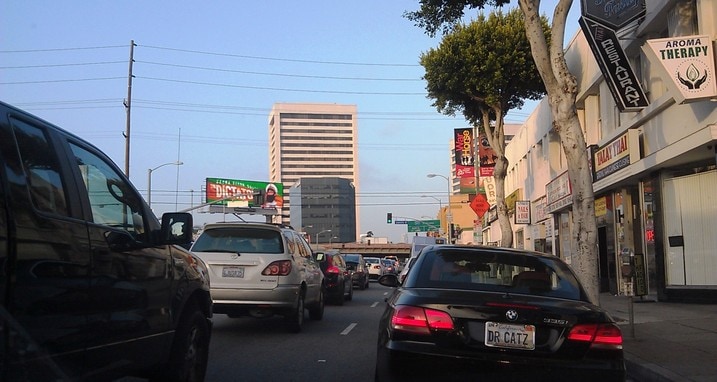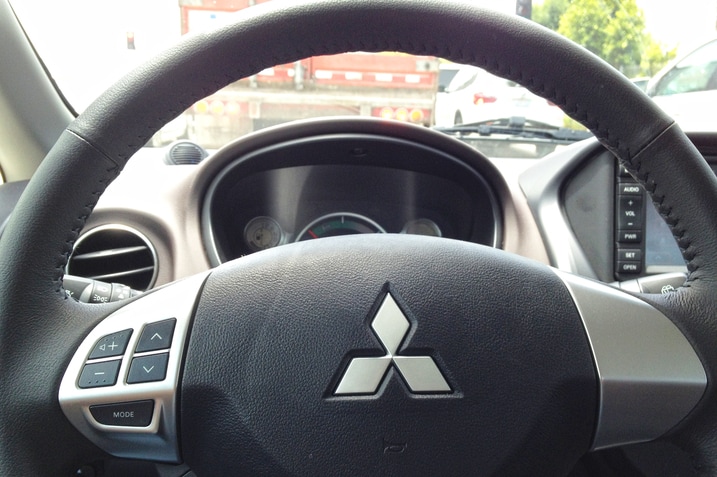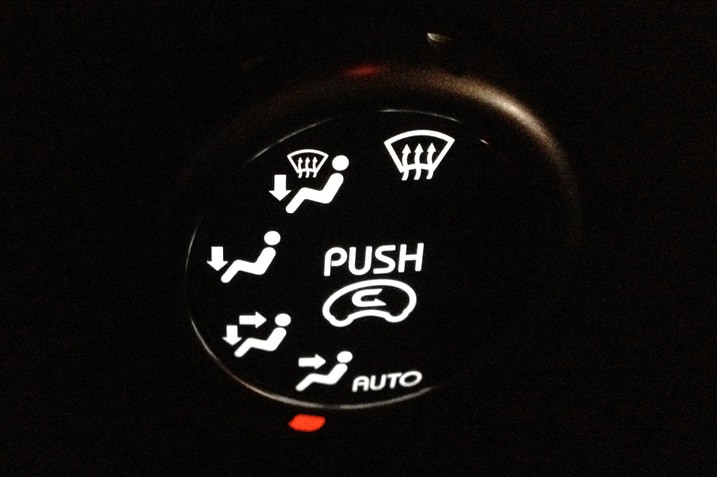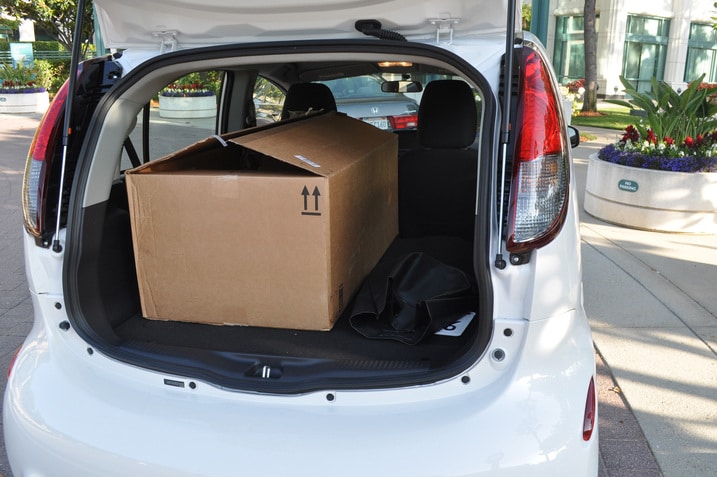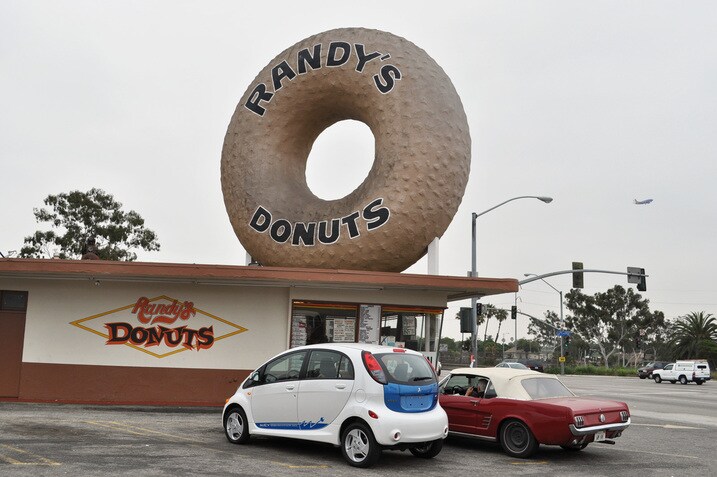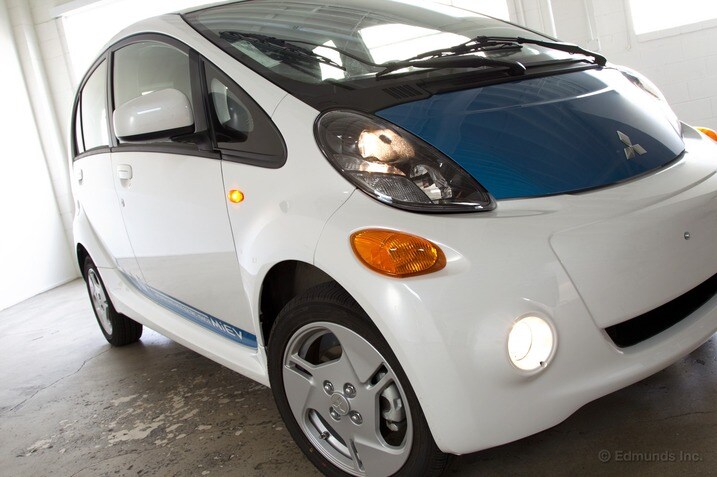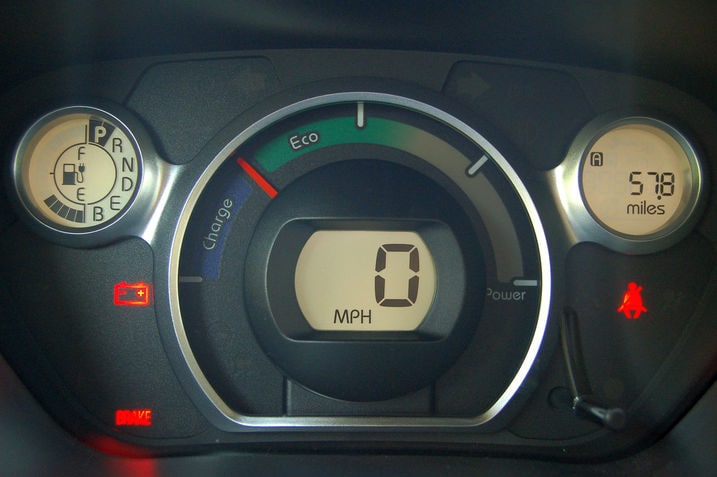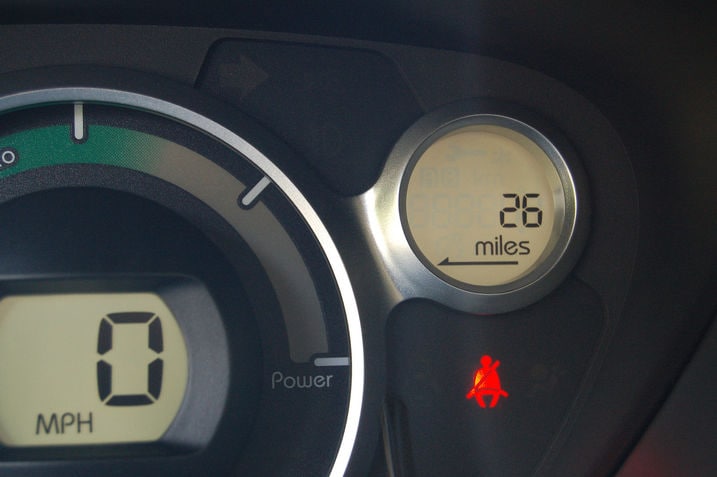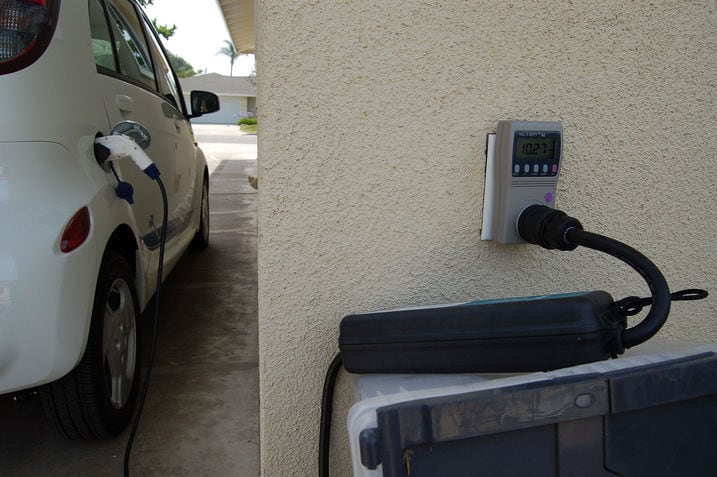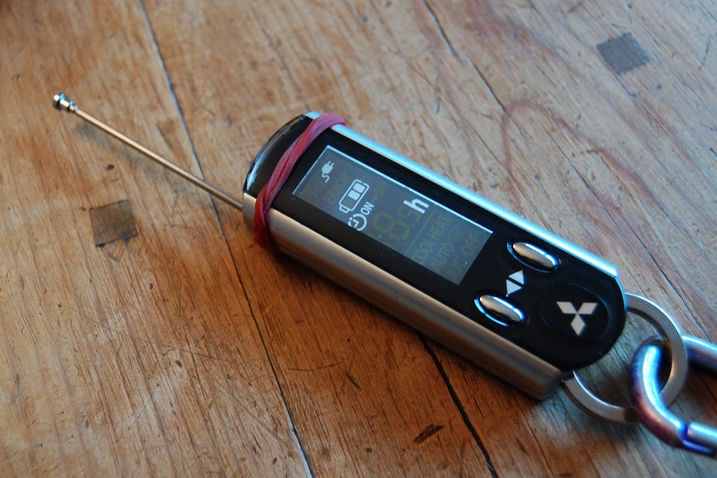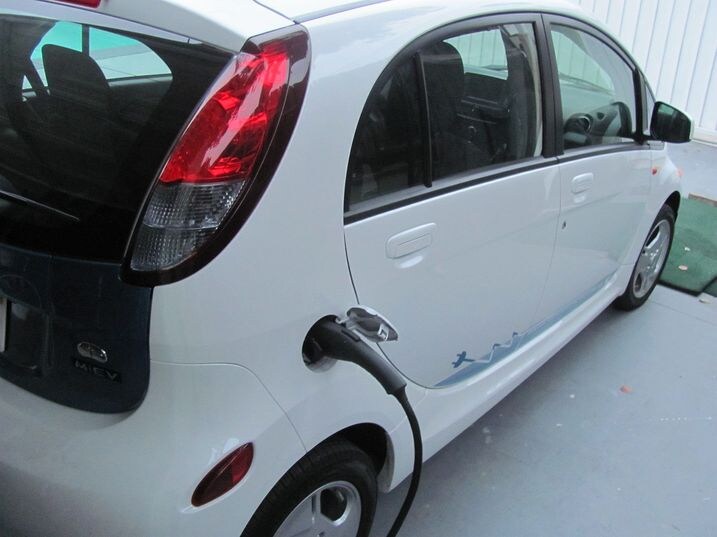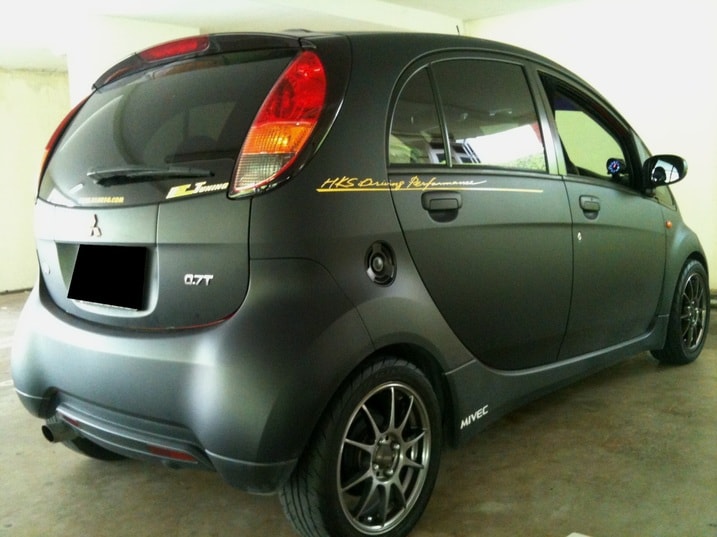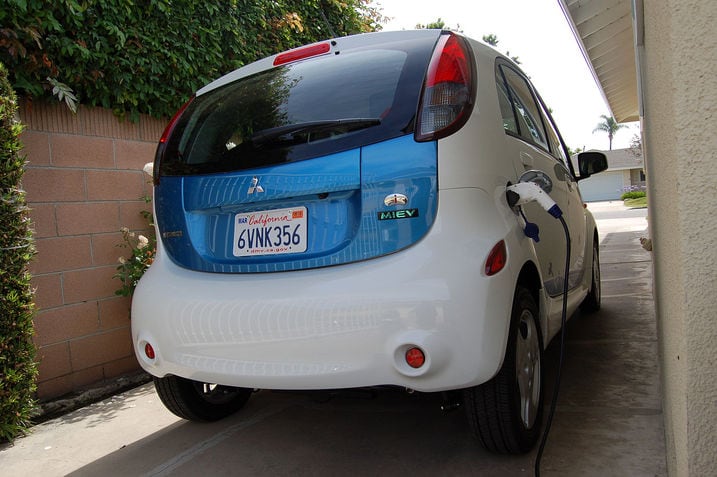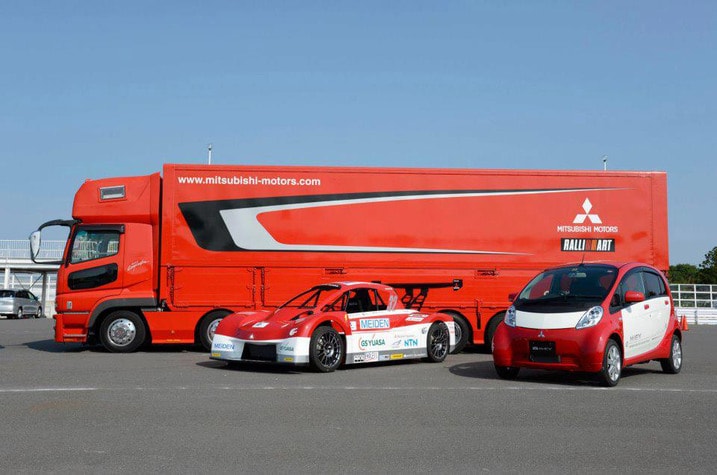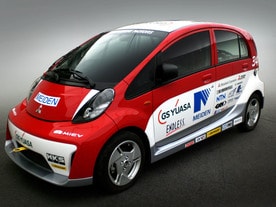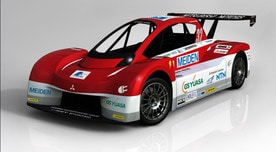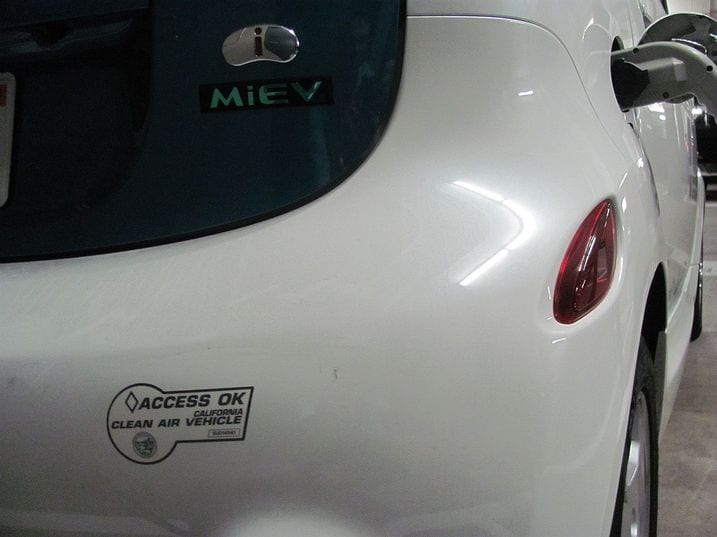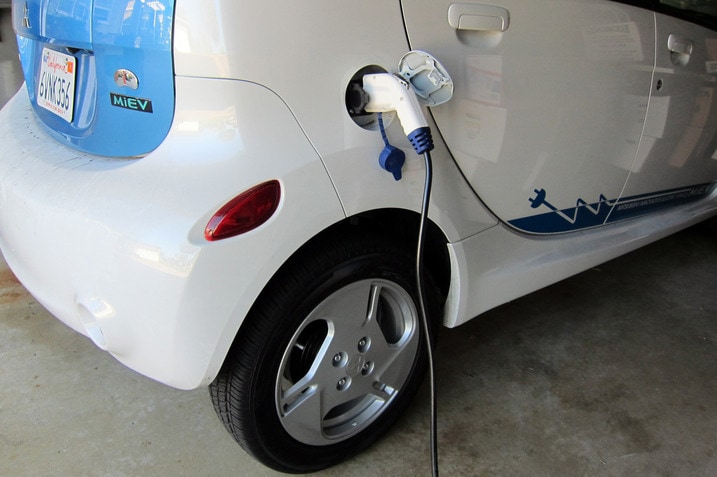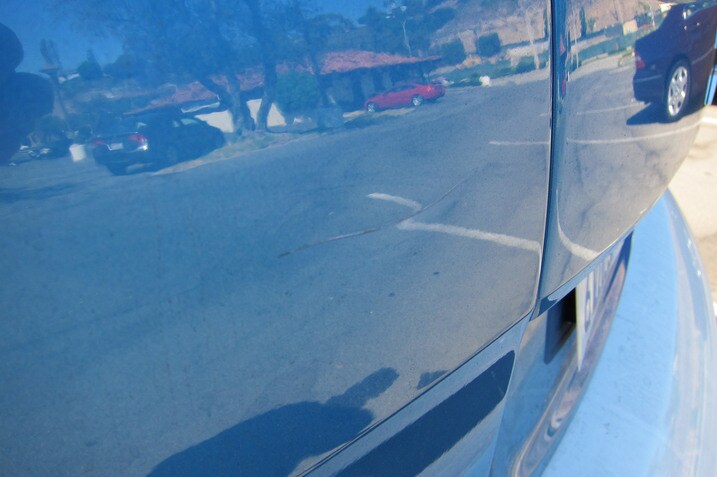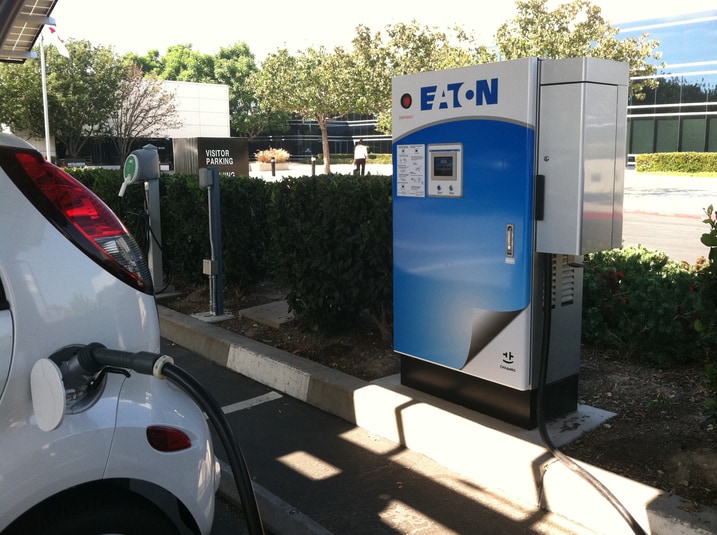2012 Mitsubishi i-MiEV: What's It Like to Live With?
Read the latest updates in our long-term road test of the 2012 Mitsubishi i-MiEV as our editors live with this car for a year.
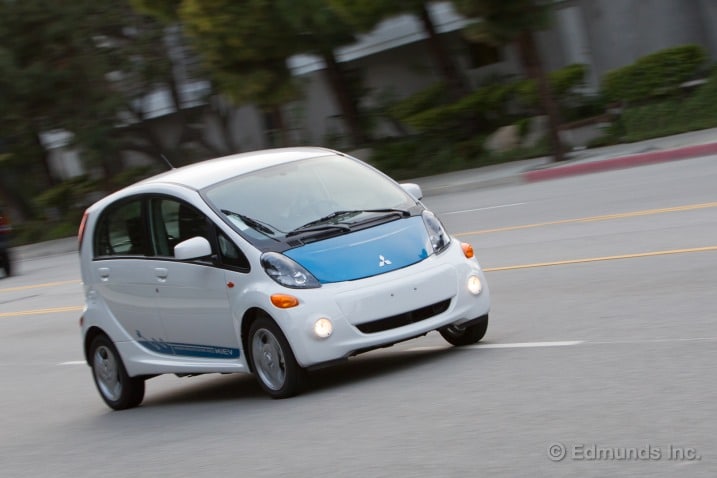
What do you want to know about?
- Introduction
- I Don't Read
- Built for Apes?
- Switching Gears
- The Remote
- Well That's Not Very Practical
- Pod
- Competitive Parking
- Did I Hurt It?
- No Graphs, No Bushes
- April Fuel Economy Update
- Works for My Commute
- Grace Jones
- I'm Trying To Like You But You're Not Helping
- Prime Condition, a Real Bargain
- Laughed At
- Interior Tour Video
- Singled Out
- What Was That?
- Mini-Me?
- A Look Underneath
- Sproing Update
- Seat Is Too Damn High
- Um, It's Easy to Park
- Wipers in Action
- We Should Have Held Out for the Evo
- 1,000 Miles!
- Natural Habitat
- I am Honored to Accept Your Waste
- Ready for What?
- New Local Dealer
- Seat Fabric Says No to Stains
- Windows Down
- Hey! I'm Driving Here!
- Geographic Desirability
- Small Touch
- Hatchback Utility? Check.
- Not So Bad on the Freeway
- Shifter Could Be Better
- Crash Test Results Not As Good As Leaf and Volt
- May and June Fuel Economy Update
- Shrek Has Good News
- Still Charging After All These Hours
- About That Remote
- A New Place to Get Charged
- Too Little Too Late
- Semi-Evil Twin?
- July Fuel Economy Update
- Ready for Pikes Peak Hill Cimb
- Recall
- Pikes Peak Results
- No Honor Among Green Thieves
- Got It for a Week
- National Plug In Day
- Gash
- Thumbs Up?
- Got a Secret
- Shopping
- August and September Electricty Use Update
- Quick Charger
- Wrap-Up
Introduction
"Subcompact cars range from 10 to 112 MPGe. The best vehicle rates 112 MPGe."
This slightly redundant message appears at the top of the window sticker of our new long-term 2012 Mitsubishi i MiEV. Next to that is the official EPA fuel economy rating for this all-electric subcompact: 112 MPGe.
Despite the press, the hype and the common wisdom, the most efficient car in America isn't a Toyota, a Nissan or a Chevy — it's a Mitsubishi, and we've got one for the next 12 months to see if it lives up to the numbers.
What We Got
The 2012 Mitsubishi i MiEV is available in two flavors, ES and SE, and both have similar starting points. It all starts with a 49kW (66-horsepower) AC synchronous motor backed by a 16 kWh lithium-ion battery pack. The motor sits low and in the rear of the vehicle atop a three-link de Dion rear suspension. From there, a single-speed, fixed-gear reduction transmission powers the rear wheels but, unfortunately, doesn't develop enough twist to break the tires loose. A shame, as we were hoping for some battery-powered burnouts.
Not that the 175/60R15 rear tires would have made much smoke. Then again if you think those are narrow, take a peek up front. Those fuel-saving skinnies are 145/65R15. Disc brakes handle the heavy work up front while drums do the trick out back. The i MiEV weighs in at 2,579 pounds.
It may not be the sexiest setup, but this is a powertrain that's good for the aforementioned 112 MPGe combined. It can do 126 MPGe in the city and 99 MPGe highway. Unfortunately, it can't do it for very long. The feds give the i MiEV a driving range of only 62 miles. Our long-term Nissan Leaf had an EPA rating of 99 MPGe but managed 73 miles of range on the feds' test. During our year with that EV, we found that the Leaf had a realistic range of 86 miles with our driving habits. Your guess is as good as ours as to what we'll get with the Mitsubishi.
Beyond the standard stuff, we opted for the SE trim level, which jacks the price to $31,975 from $29,875. This upgrade entitles us to such niceties as an eight-speaker "deluxe" audio system with 360 watts, a leather-wrapped steering wheel, two-tone instrument panel done up in brown and black, an upgrade in seat materials, cloth inserts on the door panels, 15-inch alloy wheels, foglamps and a passenger vanity mirror.
We also ticked the box for the Premium package. That $2,790 option gives us the Level 3 DC charger (for public quick-charge stations), a rearview camera, battery warning system and a 40GB HDD nav system with USB port. With only 62 miles of range, we can't see using the nav that often, but the USB port is well worth the price of admission. Finally, the two-tone White Pearl/Ocean Blue paint is an additional $300. If you're going to drive one of these, don't even bother trying to fit in. You've got to go for the bold paint.
When all was said and done, our 2012 Mitsubishi i MiEV rang up a final MSRP of $35,065. Since Mitsubishi provided the car for the test, we didn't take advantage of the various incentives available for electric vehicles.
Why We Got It
Electric cars have been on the fringe of reality as long as we can remember, but now they're slipping into the realm of reality. First we tried the Mini E and then the Nissan Leaf. Each one had its own unique benefits and shortcomings, but they were usable everyday cars.
The Mitsubishi i MiEV trades normalcy for a stand-out shape. It also trades some sophistication for exceptional efficiency, which seems like a good exchange for this kind of car. Lastly, it also signals a shift in priorities for Mitsubishi as it refocuses from performance to frugality and responsibility.
With fuel prices hitting $5 per gallon around Los Angeles, the i MiEV couldn't be hitting the market at a better time. For the next 12 months we'll find out if the 2012 Mitsubishi i MiEV is a true replacement for a traditional car, or just a quirky stopgap vehicle on the road to electrification.
Follow our Long-Term Road Test Blog for daily updates on this and our entire long-term fleet.
Current Odometer: 422
Best Fuel Economy: N/A
Worst Fuel Economy: N/A
Average Fuel Economy (over the life of the vehicle): N/A
The manufacturer provided Edmunds this vehicle for the purposes of evaluation.
It turns out I didn't read the long-term introduction for our 2012 Mitsubishi i-MiEV very carefully. Otherwise, I would have heeded this passage penned by Mike Magrath:
The feds give the i MiEV a driving range of only 62 miles. Our long-term Nissan Leaf had an EPA rating of 99 MPGe but managed 73 miles of range on the feds' test. During our year with that EV, we found that the Leaf had a realistic range of 86 miles with our driving habits. Your guess is as good as ours as to what we'll get with the Mitsubishi.
Last night I set out for Monterey Park, California, which is a 48-mile round trip. No problem, I thought, our Mini E used to make that trip so easily. This expedition was preceded by a 1.5-mile round trip to the grocery store.
Traffic was light, meaning I had to go about 65-70 mph on the drive out to the San Gabriel Valley. On the way back, it rained, reducing speeds but necessitating use of potentially battery-draining accessories like the windshield wipers.
After about 39 miles, the low battery light (aka, low fuel light) began flashing. And about 45 miles into the trip, the dreaded amber turtle illuminated.
Fortunately, the Mitsubishi is capable of adequately protecting itself from garden-variety driver stupidity. Nothing horrible happened. I drove a half-mile farther on the freeway at about 60 mph (sensing no reduction in power), then exited and drove the remaining 4 miles on familiar surface streets, which would provide a safer place to pull over if need be.
I parked the Mitsu overnight, then drove it a short distance to the office in the morning where it's now charging normally. Total trip distance was 49.8 miles (above photo was taken before the final 0.8).
So it would seem that range will be far more of a factor with the i than with the Mini E or Nissan Leaf — but the Mitsu has another tool at its disposal: a Level 3 charger. And there just so happens to be a quick-charge station (capable of restoring 80-percent charge in under 30 minutes) on the way to Orange County.
Photo by Scott Jacobs
I rarely fail to find a comfortable driving position. At 5'10", I'm pretty close to the average height of the American male adult. That's why I'm so surprised that the Mitsubishi i MiEV fits me so poorly.
When I get in a car, the first thing I adjust is the travel of the seat. I try to get the seat to a point where my legs are supported by the cushion, comfortably outstretched and have easy contact with the pedals. Then, I adjust the rake of the seatback so I can grab the 4- and 8-o'clock position of the steering wheel with my elbows bent around 90 degrees.
The problem with the i MiEV is that the steering wheel neither tilts nor telescopes. With the wheel permanently mounted too close to the dash, my arms are stretched far past my comfort zone. That leads me to believe that this car was designed with the average Japanese in mind (males: 5'7", females: 5'2"). Either that, or it was made for the average American male with ape arms.
With this in mind, I think Mitsubishi should have added a tilt and telescoping wheel for the non-Asian markets. I mean, how will tall-man Riswick drive the i MiEV?
I suppose we'll have to invest in a pair of these robot arms for him. Wait, now that I visualize that, we DEFINITELY need to get him some robot arms.
What you see here is our i MiEV'sgear selector. Nothing too far out of place here, but its operation could be better. Then there's that Eco mode.
I'll start with the actual selecting of gears. The shifter clunks from position to position with a decent, positive engagement, and that's a good thing in my book. My problem arises when I'm trying to transition from drive to reverse. Without looking at the gates as you're moving between gears, it feels as though you're just blindly bumping into obstructions. And you're never quite sure you've found the right gate.
There is a gear indicator in the instrument panel, but it's rather small. So unless I become very familiar with this car (let's say if I keep it for a week) it'll take longer for me to execute multiple-point turns.
Then there's Eco Mode. Drop the i MiEV into drive and it's not like it's a fun little rocketship; the way our Mini E was. No, it drives more like a personal transportation pod. Select Eco mode and it feels as though you're driving through a foot-and-a-half of semi-solidified Jell-O. Sure, I've driven other cars with Eco modes and they generally relax throttle response the way you'd expect. In the I MiEV, it truly feels as though something is pushing against you from outside.
In heavy traffic, it's certainly not that big of a deal. You get used to other drivers swerving into the gap in front of you. After a while, you come to expect it. Off topic: I will never get used to typing "i MiEV." In Microsoft Word, the "i" automatically gets switched to uppercase and the mix of upper and lowercase in "MiEV" makes me feel like I'm trying to spell Sarah Jessica Parker's name in L.A. Story (SanDeE).
Our new electric MiEV comes with a remote system that can monitor the charge of the battery, set charge times (to capitalize on off-peak rates) and pre-activate the climate control. I think it's a cool idea, but a remote?
That little remote looks like a tiny little cell phone from the late 1990s. Why the 90s? Because it has an antenna. But I digress.
If it were up to me (and really, I should be in charge of everything), I would have skipped the remote and developed a smartphone app instead. You know, like the one the Chevy Volt has. My reasoning is threefold: a) you don't have to carry around that remote, b) it can be updated easily and c) it can be graphically pleasing. Since I'm assuming that electric car owners are early adopters at this stage, there's a fair chance that they already own smartphones .
This all relates to one of my love of streamlining. There was a time when I was carrying a phone, Palm Pilot and iPod. I was thrilled when I combined the phone and Palm Pilot with a Treo. Imagine my joy when the iPhone came out. Perhaps this is why I am so averse to adding even one more gadget.
Considering that the range displayed in our 2012 Mitsubishi i-MiEV will show you how much power the A/C will knock down the numbers if you turn it on (from 44 to 37 miles), I thought it odd that the seat heater in the electric long-termer doesn't reset itself when you turn off the car and turn it on again. It's just an on/off button, like a light switch.
True, using it doesn't seem to use that much power (the range doesn't change when you switch the seat heater on) and you'll be able to tell when it's on just by sitting there but you'd think Mitsubishi would want to help you save as much power as possible and make this something you always have to turn on and never have to turn off.
In other news, I found out that if I wanted to save some power on a cold day to just use the seat heater instead of the draining heater itself. It's not much warmer with only my backside heated up but it's better than nothing.
Going to the gorcery store can be a competitive sport here on the west side of Los Angeles. My secret weapon is the 2012 Mitsubishi i-MiEV. Fortunately, it is compact in even the most compact of parking spaces.
Watch this viral video by FogandSmogFilms after the jump to catch a glimpse of the action.
After driving our 2012 Mitsubishi i-MiEV a few times, I've come to the conclusion that it's not meant for city life but rather for putting around marble-smooth streets within the confines of an estate.
As it is, in the city, driving over road imperfections, the car shudders and rattles. Not to say it normally does that on perfect roads. But on well-traveled off-ramp I've driven on with many of our other long-termers, the i MiEV made it sound like I plowed its front wheel straight into a huge pothole. Frightened I broke our new car, I pulled over to inspect the tires and the front end to make sure there was no damage. I've actually ended up doing this a number of times since, after driving it carefully on roads with the same seemingly minor imperfections that previous cars have handled more quietly. But fortunately there was no damage. But what's its deal?
I can't wait for Dan Edmunds to do a suspension walkaround on this thing.
I finally drove the Mitsubish i MiEV and wasn't sure what to expect as far as the gauges that show range and whether I'm driving efficiently or not . Would there be a bar graph? A pie chart? Perhaps a bush (like the Fusion hybrid) that grows leaves the more gingerly I tread on the gas...I mean electric pedal?
To my relief this electric car didn't give me the old razzle dazzle — I prefer my instruments easy to read at a glance and devoid of gimmickry. So the simple setup in the Mitsu suits me fine.
There's a needle whose movement indicates whether you're guzzling electricity, driving conservatively or sending juice (via regenerative braking) back to the battery pack. As you've likely guessed, if you want to maximize your range you want to keep the needle in the green. "Fuel" level is shown on the left along with drive selection while the right hand gauge toggles between remaining range, trip mileage, total mileage, next service mileage and outside temperature.
Truth be told, we've only had our 2012 Mitsubishi i MiEV about 1.5 months. The following tally includes the latter half of March, so you're getting 50% more for free.
Such a deal.
First, a few relevant i MiEV stats: In a standard "combined" mix of city/highway driving, the EPA says the i MiEV will consume 30 kWh per 100 miles traveled. That breaks down to 27 kWh/100 city and 34 kWh/100 highway. As always, lower is better when it comes to comsuption in kWh/100.
And then there's this:
| Long Term Vehicle |
Weight (lbs) |
Battery (kWh) |
Range (miles) |
Consumption (kWh/100) |
| 2012 Mitsubishi i MiEV |
2,579 |
16 |
62 |
30 |
| 2011 Nissan Leaf |
3,375 |
24 |
73 |
34 |
| 2011 Chevrolet Volt |
3,781 |
16 |
35 |
36 |
The i MiEV's official electricity consumption rating of 30 kWh per 100 miles comapres quite favorably to that of the Nissan Leaf and a fully-charged Chevrolet Volt.
And the EPA also says the i MiEV can manage 62 miles range from its 16 kWh battery, the same battery capacity that delivers just 35 miles in a Chevy Volt. Similarly, the i MiEV gives up just 11 miles of range to the Nissan despite a battery that's only two-thirds as big.
Simply put, the Mitsu pulls this off because it weighs 1,200 pounds less than a Volt and 800 pound less than a Leaf.
OK, fine. But how is the 2012 Mitsubishi i MiEV really doing?
| Long-Term Vehicle |
E-Consumption (kWh/100) |
E-Range (miles) |
||
| EPA |
Avg. Actual |
EPA |
Best Actual |
|
| 2012 Mitsubishi i MiEV |
30 |
29.2 |
62 |
49.8 |
| 2011 Nissan Leaf |
34 |
33.7 |
73 |
89.9 |
| 2011 Chevrolet Volt |
36 |
34.2 |
35 |
54.6 |
Our Mitsubishi i MiEV is starting off on the right foot from a consumption standpoint, beating the EPA rating just like the others did. Unlike gasoline EPA ratings, EV electricity consumption ratings are proving easy to beat.
On the range front we have some work to do. It's not that our i MiEV can't go farther than 49.8 miles, it's just that those that live far away, like me, haven't taken it home yet. So far it has mostly been in the hands of the locals, those that live close enough to make the round trip on the one charge it gets here at work.
This is the case because the iMiEV charges very s-l-o-w-l-y on 120V home current. Mitsubishi says it takes 22.5 hours to recharge an empty i MiEV battery on home current. A Volt with a same-sized battery takes just 12 hours to charge on 120V, something that is easily accomplished overnight. You don't really need a 240V charger if you own a Volt, but you do with the i MiEV. Rate of charge on home current is probably the Mitsu's biggest drawback.
As for the Volt, it's average range was 37 miles compared to a rating of 35. It's easy to squeeze every last kWh out of a Volt because, well, you can (and do) run it all the way down to zero as a matter of course.
Getting to 54.6 miles was simply a matter of optimum traffic conditons (bad, but always moving) and a who-cares attitude towards running out on the side of the freeway. But range anxiety will never allow true EVs to beat their range rating as soundly and as regularly as a Volt can.
Still, the i MiEV can and will do better. We'll determine the useful length of its leash in the coming weeks.
Our recently departed Chevrolet Volt was a great fit for my commute. I could make the 37 mile round trip in all-electric mode, despite having to go up a long, fairly steep hill through the Sepulveda Pass, which links West Los Angeles with the San Fernando Valley. And now that we have our long term Mitsubishi iMiev, I was anxious to see how it would handle the trip to and from work.
I left the office with an estimated 67 miles of range. I accelerated slowly to keep the needle in the "eco" range, but generally kept with the flow of traffic. The weather was mild, so I didn’t need to have the climate control on. I switched the car into Eco mode whenever I ran into stop-and-go traffic.
The range dropped a few points going up the hill, but I was in traffic and the car wasn't going very fast, so I wasn’t worried about running out of charge. When I arrived at home, I had traveled 18.6 miles. The estimated range read 51 miles. This was much better than I anticipated.
I had planned on charging at home, but since I had three quarters of the "tank" remaining, I figured it was safe to test the round-trip range. After all, few EV owners are able to charge on both ends, so this would be a good real-world test of the car’s worth as a daily driver.
I drove to work the following morning and made a brief stop at the Starbucks drive-through. I drove with the same technique — D mode for normal driving, and Eco mode when I ran into traffic. There was a fair amount of traffic in the morning, which allowed me to regenerate energy due to the frequent braking. I pulled into the office 18.9 miles later with an estimated 50 miles of range, or about half of the "fuel," as shown on the gauge at the left in this photo.
I doubt I could really have traveled another 50 miles (the car’s EPA rating is 63 miles total), but it was nice to know that if I owned this car, I could still make a few other small trips before having to charge.
An excerpt from Roger Moore's autobiography "My Word is My Bond":
"Christopher Walken was cast as the villain Zorin; the first Oscar-winning actor to date to play in an 007 adventure. Chris had a bit of a reputation as being 'difficult.' I never found him so ... Then there was singer Grace Jones, who was cast as May-Day. I've always said if you've nothing nice to say about someone, then you should say nothing. So I'll say nothing."
As I was driving our Mitsubishi i MiEV home last night, I couldn't help but think of Grace Jones. I think I'll take a cue from Sir Roger ...
Let me preface this post by saying that I like driving electric cars. I like the instant torque, the regenerative braking, "refueling" at home. I enjoyed our Mini E test car and the Nissan Leaf.
But this Mitsubishi is not doing it for me. I don't like that it looks like a pod. Our previous electric cars looked like normal cars and had decent interiors. The i Miev — take the electric part out of the equation — is not a good car. It's strange looking, it's too light, and is full of hard plastic bits in the interior and doesn't have enough cupholders.
The last time I drove it, I was on city streets and when I did venture onto the freeway, I was stuck in traffic and didn't get to go very fast. Last night I got to drive the car at normal highway speeds. The car feels so light that it takes work to keep it in between the lines. It bounces around at every tiny bump and struggles against the lightest of breezes. It's like punting a soccer ball down the freeway. And it let me get passed by a Smart car on the 405.
The cabin fills with wind noise even just driving it down my home block. The shifter does not light up at night. With three driving options (D, Eco and B), it helps to be able to see what you are selecting. I had to put on the overhead lamp to make my choice.
I was ready to like this car. I'm open-minded about EVs. But this car isn't helping its own cause.
To be fair, there are some things that it does well. It has nice take off when you put your foot down. I appreciate the simplicity of its gauges. It doesn't feel the need to clutter up the dash with graphics that scream "I'm Electric." It has a nice optional back-up camera. And the view out the front is wide and clear.
We have brought balance to the Universe and it's been fun.
Turning our long-term i MiEV into an astromech droid is definitely my favorite chapter in this saga. And let's not forget the projected hologram of R2-Pac. This is the droid you've been looking for.
It happened just seconds before this shot.
Scott Jacobs was shooting the i MiEV for the Long Term Introduction and I was driving. I was waiting in a private lot when a Toyota Prius full of teen boys pulled up perpendicular to me not five feet from my windshield. All five of them looked. And then one pointed. And then he laughed. And then they all laughed.
I've got thick skin — I do write on the internet for a living — I can take it. But when teenagers in a Prius laugh at you, it stings just a little. At least I was being more energy efficient?
I reduced the shakiness in this one. Let me know if it looks any better.
The i-Miev comes with a heated seat. As in one, singular (the driver's) seat. As Caroline noted, it is best to use this rather than the climate control's heater as the latter, with its fan and heating element, seriously drops range. But the lone bun warmer isn't going to win over anyone riding shotgun on a cold day. Nor anybody cross-shopping the Mitsu with the Nissan Leaf.
You see, the Leaf comes standard with front and rear (4) heated seats. And although the base i-Miev is about 6 grand less than a base Leaf, one must opt for a loaded SE like ours to (almost) get all the features that come standard on a base Leaf. At that point both vehicles are priced similarly (about $35k).
Furthermore, the nearly hidden location of the seat heater switch (in front of the driver's knee) is odd; why not put it within easier reach on the center stack? Perhaps Mitsubishi was too embarrassed as that would make it obvious that everyone but the driver got left out in the cold.
When I first start rolling out of its parking spot next its charging station, I hear a weird "sproing" noise. It's as if I drove over some sort of metallic spring plate. I couldn't figure it out, so I went to the one place where everything you read is true.
That's right, I went to the internet.
A quick scan through some message boards turned up the theory that the source of the noise is the antilock brake system testing itself. Now, I don't believe everything I read (I'm going to try telling the officer that the next time I get caught rolling through a stop sign), so I sent a message over to Mitsubishi to get a solid answer.
I'll let you know what they say. In the meantime, what do you think it is?
The i-MiEV happens upon its kid playing in the street.
Here's a look at the underbits of our long-term 2012 Mitsubishi i MiEV courtesy of our 2-post Rotary Lift. That is all.
I had a theory on the mystery of the Sproing, and now I have confirmation. My contact at Mitsubishi promptly replied to my query with, "I just talked to our R&D team here and we believe your assumption is correct with the ABS for this noise."
Good enough for me. No more worrying that I busted a rubberband or ran over a Kangaroo.
I took the i MiEV down to our studio to take a few shots of the under bits. I sat in the garage trying to get the seat into a comfortable position. I could never get it to feel right. I realized, to my surprise, that the seat bottom was just too high.
I say surprise because I am not a tall guy. But in the i MiEV I felt like I was about to scrap the ceiling with my head. I hit the down lever and it didn't budge. I could go none more lower. To paraphrase the great Jimmy McMillan, the seat was just too damn high.
This in the same vein of Mark Takahashi's complaint. I think the i MiEV is another victim of a poorly translated JDM design. Much like the first generation Honda Fit, they need to redesign the seats before they try to get the US market to embrace this niche vehicle.
"greenpony says: Can I see a video of those wipers in action?"
Yes.
The clunks you hear are, mostly, me putting the wipers into the various modes: fast, normal, intermittent.
Mitsubishi released the first official photo of its i-MiEV Evolution electric racecar which will participate in the Pikes Peak International Hill Climb on July 8. A stock version of the i-MiEV will also be running.
The single-seat racer i-MiEV Evo has a closed cockpit, all-wheel drive and a tube-frame chassis with a carbon fiber cowl.
Our long-termer i-MiEV does not.
Engineers from Mitsubishi Motors will be analyzing data from the car to further develop technology for its future EVs.
Yes, yes, this is a little early. Traditionally we do our Milestone posts on the Big Factors-of-5: 5, 10, 15, 20, 25,000 miles for our year-long, 20,000 mile tests. The thing is, we're not going to hit 20,000 miles in our 2012 Mitsubishi i-MiEV. At the end of our six-month test with the 2011 Nissan Leaf our final odometer reading was just about 3,500. Our Mini E turns in just under 8,000 in a full year.
We've had our i-MiEV for nearly six weeks and we've just cracked the 1,000-mile mark. It took us about nine weeks to hit that in our Leaf and about 8 in the Mini E. Does that mean we like this one more or just that we're more familiar with the ins-and-outs of an EV this time around. Either way, the Mini E is the mileage benchmark to beat and so far, I think we've got it.
This is why, even though our Mustang GT was available — and this from a guy whose personal car is a Mustang Cobra — I took the electric Mitsu home last night. The reality is that this is what driving in L.A. is like pretty much five out of seven days, and 412 horsepower isn't going to get you home any quicker. Taking anywhere from 35-50" to go six miles (and that's by avoiding the 10 trapped-way) is annoying enough; sitting there wasting a finite resource and adding to the air pollution here just makes it worse.
We've already bashed the i-Miev for its clown car looks and too-high price. But speaking in terms of just driving an electric car, it's fine. Step-off (acceleration from a stop) is smooth and makes more sense for driving in heavy traffic than say the neck-snapping (but admittedly fun) nature of the Mini E we had some time ago. Of course it's quiet, the ride over crappy city streets is decent and the seats are comfortable enough, even if they look like they came out of a Yugo.
I wasn't quite sure what to make of this thing in the middle of the MiEV's back seat. The first thing to pop into my mind was, "Oh god, please tell me that isn't some weird Japanese toilet-related device." I can just see it, there's a strange electronic chime followed by a pleasant voice that says, "Ready to polish bottom for happy joyous time." Then gentle fountains of warm water appear as Beethoven's Moonlight Sonata begins to softly play.
Besides that disturbing scenario that ran through my twisted little brain, I was also a bit confused by the object itself. From one angle, it looks like a handle with an "i" embossed in it. From another, it looks like some freaky square-headed six-eyed creature smiling at you with an exclamation point in its mouth.
Well, everybody can just relax. It's just a handle to access the tire inflator. Whew.
Seriously, though, what a weird place to put it and even stranger way to access it. I fear that more oddities like this have yet to be discovered.
This. This thing. This light. The one that says "ready" bugs me all the time I'm driving our 2012 Mitsubishi i-MiEV.
Because electric cars don't have that same start-up and make noise thing that real cars do, the i-MiEV says "ready" once you've started it. Unfortunately, it doesn't turn on when you're driving. Not at 6 mph, not at 60mph. It just stays on saying "Ready" no matter what you're doing. The rest of the car knows we're ready; we're driving.
Would it have been that hard to turn it off once the vehicle was in motion?
Last night I got takeout, which I picked up on the way home from work. The lid on one of the containers wasn't tightly secured. As a result, some of my lentil dahl communed with the fabric on our Mitsu's front-passenger seat.
By the time I got home, the small spill (covering half the area of a penny) had dried. I thought getting rid of the stain would involve several minutes spent scrubbing with a damp cloth.
Happily, though, that wasn't the case. I was able to remove all traces of the mishap by scraping off the dried chunks with a fingernail.
The Mitsu's flat, plain seats probably won't win any beauty contests. But that upholstery can handle a stain.
Today the temperature in Los Angeles reached 84 degrees. Not sweltering, but hot enough so that things would probably get a bit sticky if you were driving with the windows up and no AC.
I ran an errand in the i MiEV today. Around town, it was fine to keep the windows rolled down, but the errand also involved some freeway travel, and the wind noise can make open windows a pain in this situation. Still, I kept the windows down, since using the AC has a huge impact on the Mitsu's range.
Any electric-car owners out there? How hot does it have to get for you to bite the bullet and clobber your range by using the AC?
Since electric cars are oh-so stealthy, I found that it's important to have an authoritative horn in order to let unsuspecting pedestrians and distracted drivers know you're there when they clearly don't see/hear you. This is especially true while in our 2012 Mitsubishi i-MiEV, whose miniature dimensions seem to render it invisible to L.A. drivers. Just coming in to the office today, I've had three separate incidents of people switching over into my lane while I'm still in it.
The drivers' reactions to the Mitsu's horn usually unfold in the following ways:
1) "Who's honking?"
2) Check their mirror.
3) Straddle the line to see if I'm serious.
4) Return to their lane reluctantly.
In addition to having a serious horn, I also have to give the MiEV props for its responsive brakes. Pfew!
I've lived in the city in an apartment for years. Save for frequent visits to friends, who are widely scattered around greater Los Angeles, an electric vehicle could totally work for me — at least for 4-5 days out of the week.
And apart from its awkward seating position, I enjoy driving our long-term Mitsubishi i MiEV more than the Mini E and Nissan Leaf. The Mitsu's a lot lighter (2,400-2,500 pounds) and that makes it fun around corners. You can call it a glorified golf cart, but that's not an accurate description. It's a real car and the gasoline version has been on sale in Japan for years. It was among the first of the fuel-miser kei cars that offered halfway decent ride and handling. If the Smart ForTwo offered this kind of packaging, with four usable seats, it would have been a lot bigger success in the U.S. up until now.
But back to EVs. I live in the city. An EV should be right up my alley. But I live in an old apartment building (late 1940s) and have no place to plug one in — yeah, I can charge at work or at various spots around Santa Monica, but when you get home late at night, all you want is the convenience of knowing your car will be ready to go in the morning.
And for that reason, my impending move 30 miles away to a single-family home with a real garage could actually make the i MiEV a more realistic proposition — only because I'll now have an outlet to plug the car in once I return home.
I suppose you could argue that right now single-family homeowners (and home renters) are the true target audience of EVs, whereas city people in apartments are supposed to use public transportation. But this is Southern California, and there's a strong, strong pull to have your own space, your own set of wheels. EV proponents should be looking for ways to work with landlords and tenants living in older apartment/housing stock — if you could upgrade the wiring and install more external outlets in these communities (and somehow do it affordably), cars like the i MiEV could be more viable.
It makes no functional difference, but it tugs at my heart in a Hello Kitty sort of way to see that some designer cared enough to make a pictogram shaped like the Mitsubishi i itself for the recirculate button.
I'm moving to a new place very soon (and solely for the purposes of having more to blog about), so I've been scavenging boxes wherever I can find them. Yesterday, this 40-inch-long box turned up at the office and I had to have it. Then, I remembered I had our long-term 2012 Mitsubishi i-MiEV for the night, and that gave me pause. But it turns out the i MiEV is as useful as any other small hatchback, so long as you're fine with its somewhat higher floor.
It has 50/50-split rear seats, and they go nice and flat. Now you can see here that the head restraints are pressed up into the front seat-backs. I didn't remove them, so I did end up having to skooch the front seats up a bit to drop the rear seats (and then move the front seats back into position).
However, if you are less lazy than I (and who isn't, really...), the rear head restraints are easy to remove (I realized this later), and as you can see, if the head restraints were removed, there would be no clearance issue and the rear seats would fold no matter how you had the front seats adjusted.
There's no denying our Mitsubishi i MiEV is a city car at heart, but my plans changed earlier this week, and I had to hop on the freeway one morning to visit the county registrar office near LAX.
After my earlier commuting experience in the i MiEV, the one where I inadvertently tested its range, I related all that to a real live friend who actually owns his very own i MiEV (yes, bought it himself). "Aw, you must have been going 65," he said. "I go 55 and draft off trucks."
Well, this time, the pace on I-405 was only about 65, and things were only flowing around 55 in the slower lanes. I wasn't in a hurry so I stayed over there and was quite content keeping a safe distance (no drafting needed this time) behind other unhurried motorists while listening to NPR. On the trip back to the office, the pace was slower with lots of stopping and going — which is exactly the kind of driving the i MiEV likes best.
Also, it turned out this stretch of freeway is amenable to the i's skinny tires and susension calibration, as the car rode just fine, smoothly even, and didn't beat me up. If only I could get a little more seat-track travel (I have a different problem than Mark — the steering wheel is OK where it is, but my legs are all folded up), I'd probably want to drive it more often.
Aside, the county registrar is a little too close for comfort to Randy's Donuts, and the donuts and coffee are just too affordably priced.
Maneuvering our long-term Mitsubishi i MiEV in parking lots is easy-peasy, but I do wish the shifter moved more fluidly between its gates. Whenever I try to go from E or D to Reverse, it invariably hangs up in Neutral, and then it takes another firm push to get it into R.
Certainly not the first time I've encountered this scenario in a car, but in an urban runabout with a single-speed transmission, I'd expect the transitions between going forward and backing up to require a bit less thought and effort.
Crash test results are in for the 2012 Mitsubishi i-MiEV. According to safercar.gov, the consumer website of the NHTSA, the i MiEV earned an overall safety rating of 4 out of 5 stars. The Nissan Leaf and Chevrolet Volt has earned 5 out of 5 stars.
In frontal crash tests, the i MiEV earned 4 of 5 stars. In side crash tests, it earned 3 of 5 and in rollover test 4 of 5.
During the side barrier tests of the Mitsu, an interior door panel struck the torso of the rear passenger dummy, earning the rear seating area only 2 of 5 stars.
Here's a chart to compare the cars:
|
|
Mitsubishi i MiEV |
Nissan Leaf |
Chevrolet Volt |
| Overall Rating |
4 of 5 stars |
5 of 5 stars |
5 of 5 stars |
| Frontal Crash |
4 of 5 stars |
4 of 5 stars |
4 of 5 stars |
| Side Crash |
3 of 5 stars |
5 of 5 stars |
5 of 5 stars |
| Rollover |
4 of 5 stars |
4 of 5 stars |
5 of 5 stars |
A funny thing happened when I was researching my story on the 2013 Honda Fit EV: I discovered that our 2012 Mitsubishi i-MiEV also uses Toshiba's advanced SCiB Lithium-Ion battery cells, the ones with the Lithium Titanate Oxide (LTO) anodes that charge and discharge more quickly.
In the Fit EV the LTO batteries are part of the recipe that allows the use of 6.6 kilowatt charging circuitry that can draw 240V power at 32 amps and charge its 20 kWh battery in about three hours. The Leaf takes over twice as long because its charger only operates a 3.3 kilowatts.
But despite its trick LTO batteries, our i MiEV somehow manages to charge at a lower rate than even the Leaf. I have not yet confirmed why, but the 7-hour charge time suggests that Mitsubishi makes do with a 3.3 kilowatt on-board charging circuit, maybe less.
July 5 UPDATE: I have confirmed that the i MiEV does use a 3.3 kilowatt charger. I have also confirmend that the i MiEV does have Toshiba LTO batteries — in Japan. Mitsubishi USA thinks the US model might NOT have the Toshiba batteries, though. Instead the US model may use the older Yuasa non-LTO Lithium-Ion batteries, but they are confirming this with Japan.
Mitsubishi seems to have put all their eggs into the 480V quick-charge basket, which can restore the battery to 80% in just 30 minutes using a commercial grade Level 3 charger — if you can find one.
The Fit EV doesn't suppoert Level 3 charging, but until those become commonplace I like Honda's approach because 240V Level 2 chargers are what EV users will install at home.
| Vehicle |
Battery (kWh) |
Time (240/120V) |
Range (miles) |
Consumption(kWh/100) |
| 2012 Mitsubishi i-MiEV |
16 |
7 / 22.5 |
62 |
30 |
| 2011 Nissan Leaf |
24 |
7 / 21 |
73 |
34 |
| 2013 Honda Fit EV |
20 |
3 / 15 |
82 |
29 |
And though it's true the i MiEV consumes far less electricity over a given distance than the Leaf, it manages to trail behind the Fit EV in this regard even though it weighs 673 pounds less than the Honda.
In addition to any battery differences that may exist, this may ironically boil down to the Fit EV's substantially more powerful electric motor, which at 92 kW is almost twice as stout as the 49 kW unit found in the i MiEV. This works to the Fit's advantage because EV's electric motor is also the generator that vacuums up kinetic energy during periods of downhill coasting and braking, and on that score the Fit EV is better equipped to recover and recycle braking energy while on the move than the i MiEV.
But this is supposed to be about consumption. How did our i MiEV do over the last 8 weeks?
| 2012 Mitsubishi i-MiEV |
Best |
Worst |
Average |
EPA |
| Electricity (kWh/100 mi) |
22.0 |
36.5 |
29.2 |
30 |
| Observed Range (miles) |
49.8 |
|
|
62 |
| 2011 Nissan Leaf |
Best |
Worst |
Average |
EPA |
| Electricity (kWh/100 mi) |
22.0 |
53.8 |
33.7 |
34 |
| Observed Range (miles) |
76.7 |
|
|
73 |
With 1271 miles of data, our average consumption has improved from 29.2 kW/100 miles to 27.8. That's a great improvement, but it's also distorted somewhat by the reluctant attitude certain long-distance editors have towards driving the Mitsubishi home.
Short range combined with slow 120V charging times (nobody has cracked open their wallet a sprung for a 240V home charger just yet) make it hard for half the staff to even consider it. It's not too hard to deal with one characteristic or the other, but both in the same car is a real challenge.
I'm sure I could make it home, for example, but with a 22.5-hour 120V recharge time I'd have to know I wasn't going in to the office the next day (and didn't have any errands to run, either) in order to make sure I'd have a full charge for the next morning's commute. A dedicated 240V charger at home would do the job easily overnight, but I don't have one.
And so our MiEV is being driven primarily by staffers that live really close, hence the low total mileage accumulation, very good city-dominated consumption and mediocre "best" range.
You can bet I'll make arrangements to get in and drive it home before too long. It's still early days. And I'll coax some others with longer drives to give it a whirl, too.
I finally found the time needed to try our 2012 Mitsubishi i-MiEV on my long commute. Time is the operative word here because the Mitsu will need much more than a 12-hour overnight charge to replenish its battery on the 120V shore power I have at home. Mitsubishi says it takes a full 22 hours to refill an empty i MiEV battery at that voltage, in fact.
But I did arrive home to some good news: I only used about 2/3rds of the battery in getting here despite a couple of short sides trips that upped my trip distance to 57.8 miles. At this point it may take "only" 15 hours to refill the thing.
In pure range terms, the DTE meter (Distance to Empty) claims I can travel a further 26 miles if I continue at the less than torrid traffic-dampened freeway pace that brought me here. Add this figure to the trip meter and you get a theoretical ultimate range of 83.8 miles on a day that featured 45-50 mph freeway speeds and zero use of air conditioning.
I fully expect that number to shrink with clear traffic (and the A/C on, as it will be later this week.)
The MiEV acquitted itself well today — much better than I expected — but I still think it's not ideally suited to someone that lives 45 miles from work, as I do. It can't make the 90-mile round trip on a single charge, and at this early stage of EV infrastructure development I think that EV wannabees need to assume that one charge per day — at home, overnight on 240V — is all they'll have to work with.
Our 2012 Mitsubishi i-MiEV has been plugged in continuously for exactly 12 hours now, and so far 10.27 kWh of juice has passed through the cord. And no, it's not full yet. I predicted 15 hours last night, and that's looking like a solid guess at this point.
Normal charging losses amount to 10-15%, so from the battery's point of view the i MiEV has taken on roughly 9 kWh in half a day, a 120V charge rate that works out to 0.75 kWh per hour of plug-in time.
Sharp-eyed math heads will notice the hour term cancels itself out, leaving us with 0.75 kW. But I don't think this simplifed unit is as self explanatory as saying 0.75 kWh of battery fill per hour of charge time.
In similar circumstances the Leaf charges at something like 1.15 kWh per hour (1.15 kW) and Honda's as yet unconfirmed Fit EV performance claims suggest an observed 120V charge rate of 1.3 kWh per hour (1.3 kW). The relative pecking order between the i MiEV and Leaf is much the same on 240V, but I don't have the appropriate test data just yet.
Still, it turns out one of the chief measures of EV performance has do with how fast they are when they're parked.
Yesterday's 16.5-hour charging vigil (my 15-hour estimate was way off) was aided somewhat by the remote control that came with our 2012 Mitsubishi i MiEV. With it I was able to check the charging status from inside the house.
As Mark Takahashi said some miles ago it does more than that. I could have programmed a time-delay to wait for cheaper overnight rates. I could have fired up the A/C from inside the house to pre-cool the interior. And if I had a faster 240V charge station at home I might have actually done those things.
For me that little plug icon was the key feature. As long as it was visible I knew the battery wasn't full. You'd think the battery icon below would do the job, too, but it maxes out at something like 80% full. Last time I checked 80% wasn't equal to 100%, and as if to hammer that point home the i MiEV spent another 5 hours on the charger after that third bar came on. Useless; this isn't a camera.
And so the disappearance of the plug icon was the only sure sign that the battery was absolutely full, that charging was well and truly finished. An actual percent-full readout would have been significantly more useful.
And yeah, that is a rubber band. Mike Schmidt pulled this contraption out of circulation weeks ago after the snap-together plastic case cracked at the seam. How about some screws? Metal would be nice. We've barely driven the i MiEV and we've already proven that there's no way the remote could survive 4 years of swinging around at the end of a keychain, getting lighty tossed onto a nightstand or banging around inside a purse.
A smartphone app would have been far better on so many levels.
The Whole Foods down the street from the Edmunds hive recently unveiled a couple of spanking-new Blink charging stations. Now the i MiEV can get a fill-up while I peruse overpriced organic produce and gluten-free desserts.
The only surprising thing about all this is that it took Whole Foods this long to offer this amenity. This is Santa Monica, after all — a city in which green isn't a color, it's a way of life.
Have there been any new charging stations launched in your neck of the woods?
Many editors are reluctant to take this little EV home because, with a range of about 63 miles, they can't make it there and back without charging. And charging at 110 volts, as Dan Edmunds documented in his post, takes way too long. Since I own a 2012 Nissan Leaf, I have 240 volt charging at my house, so that wasn't a problem for me. Unfortunately, with the charging port in the right rear, that means I have to back into my garage from a tight turn in the alley.
But that was the least of the problems.
Let me say right up front that I wanted to like this car because I believe that EVs will have an important place in our transportation landscape. But the i MiEV actually does electric cars a disservice. Anyone driving it will be turned off and believe all the bad things that The Man says about electric cars.
So much has been written about this car that I don't want to repeat it all. A few things that bothered me were the price ($31,125 before adding options) poor driving position, the barebones interface, the lack of a charging status light and the jumpy, short wheel base feel of the car. There is also surprisingly little rear storage space.
I did like the responsiveness of the electric power train with immediate torque at most speeds. It has a great turning radius and easily fits in tight parking spaces. The range might actually prove to be better than advertised since I drove 32 miles in eco mode and used only about 18 miles of range. And, finally, my wife thought it looked cute.
Sadly, the i MiEV, together with its awkward name, came too late to the party. And with the Nissan Leaf widely available, and Honda, Ford and Tesla releasing new EVs into the market place, the forecast is not good for this odd little vehicle.
The Mitsubishi i is what as known as a "Kei" car in Japan. That basically means a tiny car with a tiny engine (which can't exceed 660cc in displacement). Available in other parts of the world since its introduction some six years ago with a 660cc turbocharged engine, the micro Mitsu in that form would seem to be a hoot. At least that's what this British auto journo thought back when it debuted. You know, the whole driving a slow car fast being more fun than the inverse deal.
A much lower price tag, a perky (around town, anyway) turbocharged gas engine and none of that annoying range anxiety might be enough to change all the negative opinions of the Mitsu i. Then again, even "murdered out", it would still look like a clown car...
The miles are not piling up very quickly on our 2012 Mitsubishi i-MiEV. After 4.5 months we're still below the 2,000-mile mark, mainly because mediocre range and slow at-home charging on the included Level 1 cordset have kept the driver pool down to those that live in there-and-back range of the 240V Level 2 charger at the office.
Phil Reed has 240V charging equipment at home, but like most other at-home Level 2 charge stations it has no readout to indicate how much electricity was just dispensed. It's like having a gas pump with no gallons readout. I've talked to many manufacturers of at-home Level 2 chargers recently, and they all say no one is asking for that feature. Really? Does that make sense to you?
I have to think the well-heeled early adopters they've polled so far, the kind of folks that can afford to overspend for an electric car, don't mind in an "I don't care so long as I'm not buying gasoline," kind of way. But knowing how much fuel is being consumed (and, by extension, how much it costs) is going to matter at SOME future point, isn't it?
Anyway, here's what we know after the July data is baked in — minus two Phil Reed Level 2 home charges of unknown quantity and the miles he drove. Sorry, Phil, I'm sure you hypermiled the heck out of the i MiEV, but without kWh data we have no idea how efficient you were.
| 2012 Mitsubishi i-MiEV |
Best |
Worst |
Average |
EPA |
| Electricity (kWh/100 mi) |
20.3 |
41.3 |
28.4 |
30 |
| Observed Range (miles) |
57.8 |
|
|
62 |
| Projected Range (miles) (Observed Range + DTE) |
83.8 |
51.0 |
64.2 |
For the most part, this was a good month for the i MiEV. It's thriftiest consumption dropped from 22.0 to 20.3 kWh per 100 miles. If you want to recast those figures in MPGe terms our best "tank" was 166 MPGe, up from 153 last month. But since gasoline isn't even remotely involved (no gas is, after all, the whole point here) I prefer not to cloud the issue. I'll stick with kWh/100 miles, the direct measure of electricity consumption.
On that note our average electricity consumption fell from 29.2 to 28.4 kWh/100 miles, and that compares very favorably to the 30 kWh/100 mile rating issued by the EPA.
Meanwhile, on the range front, our best observed range shot up a full 8 miles to 57.8 miles. I don't report worst and average range numbers because they have little meaning in the typical scenario where EV drivers plug in every day even if they only drove 4 miles to lunch and back.
Instead I like to keep track of projected range, the sum of the driven range on the trip odomenter and the remaining miles shown on the DTE gauge at each plug-in. On that basis the average projected range of 64.2 miles matches up well with the 62-mile range rating. The best projected range of 83.8 miles came on the day I drove 57.8 miles, the best observed range, with something like a third of a charge still left in the battery.
The bad news has to do with charge time on 120 V Level 1 charge equipment. This month I confirmed this EV isn't remotely livable without a 240V charger at home. Refilling those empty two-thirds took an eternity.
Not our long-termer, of course. Wouldn't that be a hoot. But there will be two i-MiEVs making the climb.
A Mitsubishi i-MiEV Evolution prototype was built specifically for the Pikes Peak race course, which is more than 12 miles long and features 156 corners.
The i-MiEV Evo has the same electric motor and batteries as the production model i-MiEV but according to Mitsubishi features a "radically sculpted carbon-fiber body, a tube-frame chassis, a unique tri-motor configuration and an advanced form of Mitsubishi All-Wheel Control (AWC) all-wheel drive."
The i-MiEV Evo will be driven by Japanese rally racer Hiroshi Masuoka.
A regular production model i-MiEV, just like ours but modified for racing and safety, will also make the run. It has a few aerodynamic adjustments and a roll cage, but it rides on the same tires as the regular i-MiEV. It will be piloted by off-road racer Beccy Gordon.
Here are some pictures:
Mitsubishi is recalling 261 i MiEVs because the side and curtain air bags may not deploy in a crash, according to the NHTSA.
No date has been set yet but Mitsubishi dealers will replace incompatible air bag sensors in the affected vehicles with new units.
Mitsubishi told federal safety regulators that there are no known claims in the U.S. involving potentially incompatible air bag sensors and that "Any customer experiencing this condition will be alerted by illumination of the SRS warning lamp."
No word yet if we have one of the 261 cars.
Remember when I told you that Mitsubishi was running two types of i MiEV in the 2012 Pikes Peak International Hill Climb and you all LOL'd.
Well, the Mitsubishi i MiEV Evolution finished in 2nd place in the electric category. The course was 12.42 miles long with 156 corners. Driver Hiroshi Masuoka finished with a lap time of 10 minutes, 30.850 seconds which put him 8th overall out of the 170 vehicles participating.
The regular production i MiEV finished 6th in the electric vehicle category as driven by off-road racer Beccy Gordon. Here's what she had to say:
"The Mitsubishi i MiEV was awesome. It produced a lot more power – especially torque – than I had expected. The handling was also very good because so much of the car's weight – the electric motor and lithium-ion batteries – sit so low in the chassis. This allowed me to carry much more speed into the corners than I expected, and the torque from the electric motor helps to propel the car out of the corners. The car is really peppy. Considering my car was 100% stock, I can definitely see all-electric cars succeeding in motorsports."
Sharp eyed commuters will immediately notice something missing here: the side carpool stickers. I took the little EV recently and jumped in assuming that it had carpool stickers. But once on the freeway, I had an uneasy feeling. As I was unplugging the charge cord, I hadn't taken time to verify that the stickers were in place. In stop and go traffic, I tried to see the reflection of the stickers in the shiny car next to me. No go. Instead, I slogged through traffic and waited until I got home to discover the horrible truth.
Apparently someone peeled off the two side stickers leaving only the one on the rear bumper. So keep your eyes open for a Silverado in the carpool lanes with our stickers.
I'll be on staycation next week and I'm taking the 2012 Mitsubishi i-MiEV with me.
I like driving electric cars because of the feeling of instant torque. But we'll see if its limited range and slow at-home charging capability become a problem for me.
Let me know if there is anything specific you want me to test while I'm away.
Today is National Plug In Day. Sponsored by Plug In America, Sierra Club, and the Electric Auto Association, there are more than 50 events happening around the U.S celebrating plug-in vehicles.
I'm celebrating by plugging in our Mitsubishi i-MiEV at home on a beautiful Sunday morning while I enjoy my coffee in the backyard.
I've been driving the i-MiEV all week on my staycation. It's been perfect for trips to the beach and local shops and restaurants. I love not going to a gas station to fill up.
I found this gash on the back of our Mitsubishi i-MiEV.
Who could be so cruel to a tiny electric car? It's like punching a teddy bear.
When I left the office last Friday ready to start my staycation, I hopped on the semi-busy freeway. It was actually moving a little and a pickup truck with five guys in it pulled up next to me and honked until I looked over. Then they gave me a thumbs up for the car.
That only happens when we drive something exciting like the Nissan GT-R. I was a little surprised because despite the i-MiEV's peculiar looks, it usually doesn't get much attention from other commuters.
But then I went to dinner at a local restaurant where the people know where I work. They always come out in the parking lot to see what I am driving. One of the guys didn't like its looks or interior materials. But the restaurant owner who is a woman in her seventies thought it was cute and very practical for her errands around town.
As I drove around last week, keeping to my own neighborhood, I noticed seniors looking at the i-MiEV. Perhaps it has found its audience, although I haven't seen any on the road. Have you?
I like to use cupholders for storage for my phone, my access cards, some change, etc.
Our Mitsubishi i-MiEV has one cupholder at the back of the center console which I don't find very convenient. It also has some storage under the center stack which is out of reach while you are driving.
But then I noticed that on each side of the dash, there is a flip-down cupholder. It's squarish in shape and although I don't usually have a cup of anything, it held my garage door opener and assorted stuff.
It's not exactly a secret compartment but I admit I never noticed them before.
Have you ever gone to the market with a modest shopping list and come out with bags and bags of stuff? I do that all the time and usually don't think anything of it. Until I came out to the parking lot and remembered I was driving a tiny electric car.
But unlike the Mini E experiment, the Mitsubishi i-MiEV actually has quite a bit of cargo capacity. With the second row in place, there is room for four or five supermarket shopping bags. Drop the second row and you get more than 50 cubic feet.
I was too lazy to remove the headrests so that the second row would have room to lie flat. So I put my extra bags on the back seat. Worked perfectly.
Our 2012 Mitsubishi i MiEV continues to be used by editors that live fairly close to the office and its 240V SAE charge station. The location of our charge equipment isn't all that unrealistic because most EV owners only have access to one 240V charger. Our commute is bass ackwards, is all, with the charging equipment on the work end instead of the home end.
Here is how things stand with August and September added in.
| 2012 Mitsubishi i MiEV |
Best |
Worst |
Average |
EPA |
| Electricity (kWh/100 mi) |
20.3 |
41.3 |
28.1 |
30 |
| Observed Range (miles) |
57.8 |
|
|
62 |
| Projected Range (miles) (Observed range + DTE) |
83.8 |
45.0 |
62.6 |
Because that's only 1,980 miles of driving. Clearly, no one is lining up to take this one home.
The reluctance that certain editors have to driving this car boils down to a couple of issues: the utter bare bones-edness of the car itself and fear of its short range. 62 miles isn't exactly stellar and range anxiety kicks in big time as you approach 50 miles.
Sure, it can be topped up at home on 120V, but as I've said before the i MiEV is one slow charging EV. But that was speculative, based on manufacturer estimates. Since then I've timed it using the same 120V outlet at my house.
The new 2012 Honda Fit EV added 1.25 kWh to its battery for every hour it was plugged in. Factoring in its 29 kWh/100 EPA consumption rate we can say it charges at 4.3 miles per hour, as in miles of driving per hour of charging. Use our observed 24.8 kWh/100 consumption figure instead and the effective charge rate climbs to 5.0 miles per hour.
Similarly, the Focus Electric added 1.30 kWh to its battery during each hour on the plug. Its EPA rating of 32 kWh/100 miles translates that to 4.1 miles per hour of charging. In actuality it used only 28.4 kWh/100 miles during its time with us, so our actual 120V charge rate was 4.6 added battery miles per hour.
And the i MiEV? It can only add 0.75 kWh to its battery every hour it's plugged in. With an EPA consumption rating of 30 kWh/100 miles, the nominal charge rate is just 2.5 miles per hour. But as you see above we've averaged 28.1 kWh/100 miles, which bumps the observed charge rate to 2.7 miles per hour.
It all boils down to 5.0 and 4.6 compared to 2.7 battery miles per charging hour.
Meager range after you've filled at the preferred 240V charging station is one thing, but the fact that 120V top-ups take forever is something else entirely. I can't refill the battery overnight here at my place and still make it to back to the work charge station on time is another. Those that do their primary charging at home and top up with 120V at work or wherever they go during the day face the same issue in reverse. Slow top-up charging makes a small radius of operation that much smaller.
Even though it is not often discussed, charging speed, be it 240V primary charging or 120V top up charging, is an EV attribute that, to me, stands on equal footing with the range itself.
The guys at Mitsubishi were telling us that they had set up a station to recharge i MiEVs, so we rushed right down there.
Actually "rushed" might not be the right term, since we drove down to Mitsubishi HQ at 60 mph, which Mitsubishi product engineer Dave Wong tells us is the sweet spot for freeway cruising — a speed that gets you there, yet doesn't suck more juice out of your battery than you expect.
Life is surprisingly different over there in the slow lane. First of all, 60 mph is just fine, and you don't need to worry about getting run down from behind, even in Los Angeles. There are trucks, though not as many as you'd think. There are interesting cars of the past, though not as many as you might think. And the standard of driving and the relative level of civility might be a little higher than in the left lanes (turn signals are occasionally used while maneuvering, for example). Of course, the wobblers in the right lane are indeed frequently terrifying.
This Level 3 Eaton DC quick-charger is rated at 50 kW, so you get a significantly faster charging experience than you do with the 3.3 kW charger than an EV like the Mitsubishi i MiEV or Nissan Leaf carries on board. (6.6 kW chargers are just entering the EV market with cars like the Ford Focus EV.) Indeed it turns out that the charger itself is the real limiting factor in the speed of recharging process, not the capacity of the EV battery.
In any case, we showed up at Mitsubishi with about a 50 percent charge of the iMiEV's battery after the 37 mile trip from Santa Monica. We plugged into the Eaton DC and then left for lunch, and I'll bet the charging was completed before we ever got to that Peruvian place in nearby Buena Park.
L3 DCQCs like this one will start showing up in public places as EVs become more common. As they do, it'll be possible to extend the useful driving range of an EV, since you'll be able to power up on the go. Maybe you'll even start lunching at Peruvian restaurants.
Wrap-Up
What We Got
Electric cars are here to stay. Our early long-term test of the Mini E was our first taste of life on electricity. A subsequent half-year test of the Nissan Leaf proved EVs were no fad. Next up was a test of the 2012 Mitsubishi i MiEV.
The 2012 Mitsubishi i MiEV tread lightly in more ways than one. Its rear-drive AC synchronous motor was rated at just 49 kilowatts (66 horsepower), fueled by a 16 kWh lithium-ion battery pack mounted in the back. It wore staggered-width tires sized 175/60R15 in the rear and a downright puny 145/65R15 up front. In all, the electric waif weighed less than 2,600 pounds.
With a base MSRP of $29,875 and numerous incentives, the i MiEV ranked among the most affordable electric cars available. We ordered the high-line i MiEV SE model. This raised the price to $31,975 and provided accoutrements like an eight-speaker audio system, cloth door panel inserts and a passenger-side vanity mirror. On top of that, there was the $2,790 Premium package, which added a Level 3 DC charger for quick-charge stations, a rearview camera, low-battery warning system, foglights, a 40GB hard-drive-based navigation system, Bluetooth and a USB port. Another $300 bought a two-tone White Pearl and Ocean Blue paint job.
Mitsubishi supplied the $35,065 i MiEV SE to us for 6 months. We set out to see how well its EPA-estimated 62 miles of range fit with our daily lives.
Our Impressions
The Mitsubishi i MiEV trades normalcy for a stand-out shape. It also trades some sophistication for exceptional efficiency, which seems like a good exchange for this kind of car. Lastly, it also signals a shift in priorities for Mitsubishi as it refocuses from performance to frugality and responsibility." — Mike Magrath
"Traffic was flowing about 65-70 mph on the drive out to the San Gabriel Valley. On the way back, it rained, reducing speeds but necessitating use of potentially battery-draining accessories like the windshield wipers. After 39 miles the low battery light began flashing. And about 45 miles into the trip, the dreaded amber tortoise illuminated. Fortunately, the Mitsubishi is capable of adequately protecting itself from garden-variety stupidity. I made it home and nothing horrible happened. Total trip distance was 49.8 miles." — Erin Riches
"It turns out one of the chief measures of EV performance has to do with how fast they are when they're parked." — Dan Edmunds
"The i MiEV acquitted itself well today — much better than I expected — but I still think it's not ideally suited to someone who lives 45 miles from work, as I do. It can't make the 90-mile round trip on a single charge, and at this early stage of EV infrastructure development I think that EV wannabes need to assume that one charge per day — at home, overnight on 240V — is all they'll have to work with." — Dan Edmunds
"Our i MiEV has been plugged in continuously for exactly 12 hours now, and so far 10.27 kWh of juice has passed through the cord. And no, it's not full yet. Normal charging losses amount to 10-15 percent, so from the battery's point of view the i MiEV has taken roughly 9 kWh in a half day, a 120V charge rate that works out to 0.75 kWh per hour of plug-in time. In similar circumstances the Nissan Leaf charges at something like 1.15 kWh per hour and Honda's Fit EV claims 1.3 kWh per hour." — Dan Edmunds
"On the trip back to the office, the pace was slower, with lots of stopping and going — which is exactly the kind of driving the i MiEV likes best. Also, this stretch of freeway was amenable to the i's skinny tires and suspension calibration, as the car rode just fine, smoothly even, and didn't beat me up. If only I could get a little more seat-track travel, I'd probably want to drive it more often." — Erin Riches
"The last time I drove the i MiEV, I was on city streets and when I did venture onto the freeway, I was stuck in traffic and didn't get to go very fast. Last night I got to drive the car at normal highway speeds. The car feels so light that it takes work to keep it between the lines. It bounces around at every tiny bump and struggles against the lightest of breezes. I was ready to like this car, but the Mitsubishi isn't helping its own cause." — Donna DeRosa
"I was waiting in a private lot when a Toyota Prius full of teen boys pulled up perpendicular to me not 5 feet from my windshield. All five of them looked. And then one pointed. And then he laughed. And then they all laughed. I've got thick skin — I do write on the Internet for a living — I can take it. But when teenagers in a Prius laugh at you, it stings just a little. At least I was being more energy efficient?" — Mike Magrath
"Sharp-eyed commuters will immediately notice something missing in this picture: the side carpool stickers. I got home to discover the horrible truth. Apparently, someone peeled off the two side stickers, leaving only the one on the rear bumper. So keep your eyes open for a Silverado in the carpool lanes with our stickers." — Philip Reed
"I finally drove the i MiEV and wasn't sure what to expect as far as the gauges that show range and whether I'm driving efficiently or not. Would there be a bar graph? A pie chart? Perhaps a bush that grows leaves the more gingerly I tread on the gas? To my relief, this electric car didn't give me the old razzle-dazzle. I prefer my instruments easy to read at a glance and devoid of gimmickry. So the simple setup of the Mitsu suits me fine." — John DiPietro
"I sat in the garage trying to get the seat into a comfortable position. I could never get it to feel right. The seat bottom was just too high. I think the i MiEV is another victim of a poorly translated design from the Japanese domestic market. Much like with the first-generation Honda Fit, Mitsubishi needs to redesign the seats before they try to get the U.S. market to embrace this niche vehicle." — Scott Jacobs
"The i MiEV is as useful as any other small hatchback, so long as you're fine with its somewhat higher load floor. It has 50/50-split rear seats, and they go nice and flat." — Erin Riches
Maintenance & Repairs
Regular Maintenance: Our abbreviated test of the 2012 Mitsubishi i MiEV did not allow enough time to reach the first scheduled service interval of 12 months or 15,000 miles. Had we made it, the maintenance would have included a handful of tests and inspections: transmission oil, brake pads and rotors, brake hoses, driveshaft boots and main battery capacity. The service tech also would have replaced the cabin air filter. Routine service follows a 15,000-mile interval for the life of the vehicle. Severe service calls for 3,750-mile increments.
Service Campaigns: One recall was issued on the i MiEV during our test. Mitsubishi announced a recall of 261 units because, according to the National Highway Traffic Safety Administration, the side and curtain airbags may not deploy in a crash. The company said, "Any customer experiencing this condition will be alerted by illumination of the SRS warning lamp." Our test car was not part of this recall.
Fuel Economy and Resale Value
Observed Fuel Economy: When it comes down to it, range is the most important consideration when you're shopping for an electric car. The EPA estimated our 2012 Mitsubishi i MiEV could travel 62 miles on a full charge.
Our average projected range, as displayed by the instrument cluster following a full charge, was 62.6 miles during our 1,900-mile test. At a glance, this suggested the EPA figures were accurate. But remember that these are just projections. Our best observed range was lower, at 57.8 miles.
The EPA also said the Mitsubishi would consume 27 kWh of electricity per 100 miles during city driving and 34 kWh/100 during highway travel, with a combined consumption rating of 30 kWh/100.
During our six-month test, the i MiEV beat the government's combined rating, consuming electricity at an average of 28.1 kWh/100. Our best and worst refills required 20.3 kWh/100 and 41.3 kWh/100 of electricity, respectively.
Resale and Depreciation: Resale value was not available for the Mitsubishi i MiEV at the time of this test.
Summing Up
Pros: Its small size is great for maneuvering in the city. Despite these proportions, its fold-flat second row and rear hatch offer decent utility. Optional hardware to accept a Level 3 charger is a plus.
Cons: The EPA estimates just 62 miles of range. Our best was less than 58 miles. Charge time was another obstacle. In our experience, a Level 2 charger filled an empty i MiEV in about eight hours. At 120V, it was closer to 22 hours.
Bottom Line: For city driving, the 2012 Mitsubishi i MiEV was adequate. But range and charge time were the real hurdles. A range of 58 miles isn't much, but an 8-22-hour refill time is certainly a big deal, especially since most owners won't have access to a Level 3 charger.
| Total Body Repair Costs: | None |
| Total Routine Maintenance Costs: | None (over 6 months) |
| Additional Maintenance Costs: | None |
| Warranty Repairs: | None |
| Non-Warranty Repairs: | None |
| Scheduled Dealer Visits: | None |
| Unscheduled Dealer Visits: | None |
| Days Out of Service: | None |
| Breakdowns Stranding Driver: | None |
| Best Fill: | 20.3 kWh/100 |
| Worst Fill: | 41.3 kWh/100 |
| Average Fill: | 28.1 kWh/100 |
| Best Observed Range: | 57.8 miles |
| Best Projected Range: | 83.8 miles |
| Worst Projected Range: | 45.0 miles |
| Average Projected Range: | 62.6 miles |
| True Market Value at service end: | Unavailable |
| Depreciation: | Unavailable |
| Final Odometer Reading: | 1,984 miles |
The manufacturer provided Edmunds this vehicle for the purposes of evaluation.
